#the lore I have for this is immense comparing to the actual fan work I have
Explore tagged Tumblr posts
Text
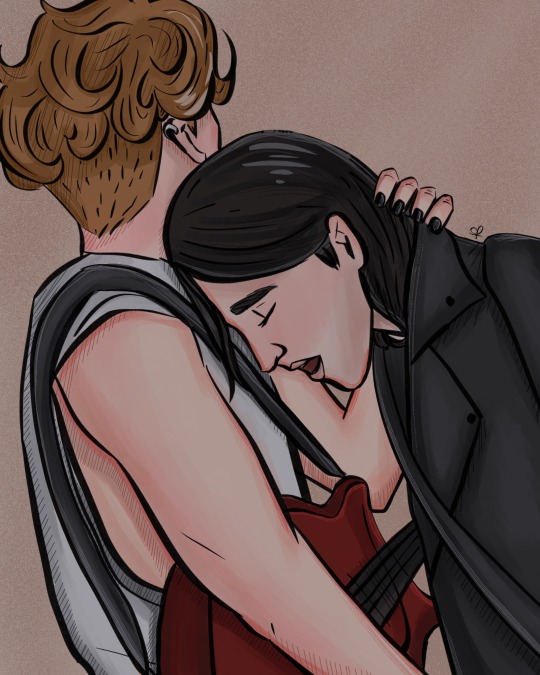
I might be too drunk, and he might be too high, but I'm looking at him, and he is looking straight back at me and suddenly the crowd is gone, it's only us. No crowd, no cameras, so if I get close it's just for us and if I sing it's just for him.
#carry on#snowbaz#simon snow#baz pitch#rainbow rowell#wayward son#any way the wind blows#simon snow series#simon snow trilogy#bandom au#coming soon in fic format maybe most def in art format#the lore I have for this is immense comparing to the actual fan work I have#so ask me about it lol#my art
37 notes
·
View notes
Note
Hi there!
I know you might get a ton of messages regarding Pieces, so this might be redundant, but I join the appreciating gang here.
I just wanted to say thank you for that amazing take on the ascendant and giving us a real fix-him/save-him story! 💙 I have to say, this is maybe the first ever AA story I actually liked, and damn I can't emphasize enough how immensely I do so.
I am a huge fan of Rose, she is such a seriously well done OC, with flaws, story and personality. I often reread Party Favours for her personality alone as well, but Pieces really went up and beyond establishing how different she is since her original state.
But maybe the biggest plus for me, that made me adore this fic the most, was how much actual dnd lore there was. The spells and items used were very on point, as I usually commented under the chapters. 😅 Those made my nerd brain go crazy there.
So just wanted to say congratulations on finishing it and thank you! 💙
kind messages are never redundant, my love. thank you for taking the time to speak with me, that act means a lot :)
I'm really glad you enjoyed it! I'm not sure how Pieces compares to other Tav/Ascended!Astarion dynamics, but I knew this would be how it played out in Rosalie's timeline specifically. A very fun, very fucked up mixture of both their bad endings, guilt, and neither of them being able to change - Astarion being frozen in at a point of self-loathing because of how I conceive of Ascendency and just desperately trying to find a solution that won't work, and Rosalie honestly just being so stuck in a moral binary that even if she lowkey wanted an Ascended!Astarion (which, um, she did) she'd never be kind enough to herself to let herself have it. I mean what I said in previous asks, about the appeal of the AU being that it was tragic for the both of them, which I guess is why Rose 's personality and her own issues ended up featuring so heavily.
Luckily the plot (informed by several of my favourite fictional dynamics) made all of that legit in the end!
Writing a higher level wizard was honestly so very fun, and I'm glad you enjoyed the mechanics because it was also my self-indulgent excuse to do things I'll probably never get a chance to do in an actual D&D game! My sorcerer got to Level 13 in Curse of Strahd and so I did get a taste of that sexy high-level spellcaster life, but Pieces allowed me to play around with spells in a way that wouldn't really work within an actual game narrative :) I love D&D's worldbuilding (not the actual worldbuilding, with all the Problems, but the way spells and magic works on paper) so a Level 18-19 character was a really fun way to indulge that.
I'm so glad you enjoyed it, thank you so much for sharing it with me :D
4 notes
·
View notes
Note
Hello! 👋
This is a different anon! Your Megumi+Gojo and Shiho+Shizuku comparison actually got me thinkin’ 🤔
Would you say that Megumi’s relationship with Tsumiki is a better comparison to the Hinomori Sisters? 🤫
I don’t know much about the sisters personally, but the way you describe them in that post sort of reminds me of Megumi and Tsumiki! ☺️
Ngl, I had to look up who was Tsumiki since I didn’t recognize the name LOL
Hmm… Megumi’s relationship with his sister, huh? :oc
I mean. I suppose those two are a better comparison than Gojo and Megumi. Since at least they are similar in ages and are siblings. Hmm.
(More under the cut)
Honestly, I personally don’t have much thoughts on Megumi’s relationships with his sis tbh.
I think it’s because how we don’t really get to actually know whose Tsumiki is. And that’s very intentional in jjk since the purpose was to show that Megumi never actually get to know Tsumiki as a person.
Megumi only knew Tsumiki as an idea in his head. And so we never get to actually the real Tsumiki.
All we know is that Tsumiki seems to take on the role of a sort of caretaker for Megumi and was apparently kind. But we only get that information from Megumi’s pov, iirc. :oc
So that information could have been super biased.
And in Project Sekai, we actually get to know both Shizuku and Shiho.
Since both are part of the main cast within Project Sekai (there’s like 20 of them in total. Don’t worry, it’s great~). So we get to know how both act, think, and talk to one another.
And I think Shizuku and Shiho’s relationship are much healthier than Megumi and Tsumiki’s. Since I feel like the Hinomori’s actually get to understand each other and know each other so deeply, ya know?
Yes, Shizuku took care of Shiho emotionally when their parents couldn’t (similar to how Tsumiki took care of Megumi), but Shiho doesn’t have this idealized version of Shizuku in her head where Shizuku can’t do anything wrong.
Shiho’s is super aware of Shizuku’s flaws and still accepts/loves her for it. And because of that Shiho was one of the only few people that Shizuku could comfortably be herself around and not have to live up this “perfect, mature, and mysterious” mask of Cheerful*Day Shizuku. (Of course Shizuku would still hide her pain away from Shiho during her time within Cheerful*Days but that’s a separate issue lol)
I think Shiho just idealized Shizuku a normal amount compared to Megumi imo.
But I suppose there was this one time where Shiho did almost idealize Shizuku too much tho. :oc
In a story event where Shiho remembers her first time doing an Tsukimi during kindergarten (it was the same time when Shizuku comforted Shiho when their mom wasn’t able to show up), Shiho realizes how much Shizuku has supported her while she feels like hasn’t done so towards her at all.
But within that story event, when Shiho told these feelings to the Vocaloids within her Sekai (it’s a whole lore thing lol, ya don’t need to know kek) and how Shiho really sees how much Shizuku is working hard on her profession as being an idol. Shiho felt like she couldn’t compare, and that she felt like she never had supported Shizuku like how Shizuku has supported her.
However, Miku told her that she thinks it’s not true and suggested that Shiho have supported Shizuku in ways that she didn’t even realized.
At first Shiho was hesitant about how true that statement is, but near the end of the day, when Shiho decided to watched the livestream of MORE MORE Jump…
Shiho gets to see Shizuku telling her fans how much Shiho means to her and how Shiho’s presence during her childhood has helped her immensely for she never felt alone due to Shiho always being there. And how Shiho’s determination and dedication towards her dream even during hard time has help inspire Shizuku during her own hard times to always try to do the same within her own idol career. Thus why Shizuku would wish for Shiho to let her take care of her little sister since she felt like Shiho has always supported her.
And while Shiho is a bit embarrassed that Shizuku talked about their childhood memories to her fans, Shiho is deeply touched to learn that Shiho has been supporting Shizuku as much as Shizuku has to her. Hence, put the end of Shiho idealizing Shizuku too much and think lesser about herself in comparison.
While Megumi… well. For those whose caught up with the jjk manga (honestly I haven’t caught up, i only remember reading the beginning of Gojo vs Sukuna fight before getting hyperfixated on bg3 lol), then ya know how the Fushiguro siblings storyline has ended.
But yeah. Those are my thoughts. Thanks for the ask! ^w^/
#the fact that there really isn’t a fushiguro sibling tag is really saying a lot lol#my txt#my thoughts#my ramblings#project sekai#jjk#jujutsu kaisen#pjsk#prjsk#pjsekai#prsk#shizuku hinomori#shiho hinomori#megumi fushiguro#tsumiki fushiguro#hinomori sisters#hinomori siblings#asks#ask#character analysis
4 notes
·
View notes
Text
My BooRai WIP stats

So. As of right now, the number of written BooRai fan works I've published is...... zero. I recently announced my angst fic I Can Stop The World, with another reveal planned in a few weeks, but I've yet to actually publish anything 😭
Last night I was backing up all my WIPs, and I decided to go through and reorganize everything. I moved everything into new folders and checked their word counts. I was a little surprised by the numbers to be honest. Especially when compared to this word count update from 5 months ago: [link]
I thought it would be fun to post my stats so you can see how much I've been working on, even though I haven't started posting yet.
As of last night:
Total number of Google docs: 34 Outlined fics: 21 (mostly longfics) Comic WIPs: 7 Completed fics: 1 (a one-shot I'm not ready to post yet 😭) Ideas yet to be fleshed out: 12 Total BR fanfic word count: 517,362 Words this week: about 25,000
ICSTW (main angst fic, post-canon):
196,871 words 6 docs
SSATSF (Modern AU, upcoming reveal):
125,474 words 3 docs
Folklore AU (started recently):
23,289 words 2 docs
Comics (text only)
80,795 words 7 docs
Reference docs (OC masterlist, headcanons, language dictionary, etc.)
9149 words 5 docs
Okay, pause real quick. The first BooRai fic I started writing is a fluff comic (briefly mentioned here) that I started in late 2022. It was my only project until the day I started writing ICSTW in June 2023. Then I exploded in ideas and here we are. So, if I exclude that first comic's word count of 36,190...
...Then the total word count of BooRai fanfic I've written in the past 7 months is 481,172 words. That's about 2217 words per day, and 15,522 words per week.
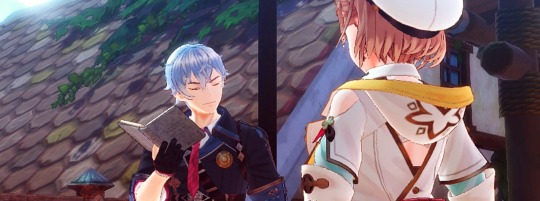
Now. This all just a bunch of numbers. Numbers don't mean the fics are any good. I value quality over quantity, so you can see why I haven't published anything yet. The ideas are all there! Tons and tons of dialogue is written. Detailed lore is laid out. Languages have been constructed! But the chapters themselves are not written. I don't write chronologically, and my stories are very elaborate. So even my main two fics, at 196k and 125k, are nowhere near complete. I haven't even finished fleshing out the early chapters 😭
You might be looking at this and thinking like.... "yeah bro you're not gonna finish most of those fics. It's not happening. You're gonna burn out." Mayhaps! I have a tendency to overdo things, and sometimes I overwhelm myself by making things bigger and more complicated than they need to be. But all in all, I like the way I create and I like having a few big projects and lots of tiny ones. I'm deeply invested in my major projects and I really do want to dedicate myself to publishing chapters in the next few months. But if I never finish them, that's okay too! The important thing is to enjoy making the thing... and I enjoy it immensely. Enough to write half a million words in 7 months, apparently
I've talked about my fic content to some irl people and they always respond with: "When the hell do you do all this? I literally never see you writing." In reality, yes they do. if you see me typing on my phone, I'm most likely writing. I kind of high-key spend 100% of my free time drawing and writing now. Which is a miracle after years of art block and creative sterility.
Another reason I wanted to share my numbers is that there are a lot of fellow AuDHD creators on this site, so there are bound to be at least a few of you who work just like I do. If you're one of those people, you probably know that it's easy to feel like the projects will never come to fruition. Don't lose heart!!! You have the strength to finish your projects at your own pace!!! And if you simply lack the will to finish, that's also okay! If you enjoy just writing down ideas without committing to a fully fleshed out work, that's a perfectly legitimate form of art and recreation. Godspeed my friends.
And as for the people who have been supporting my BR art and keeping track of my fic updates... You are the world and I am but a humble bean in service of your fancies. Thank you for your support. Here's a picture of me rereading my WIPs for the billionth time while y'all stand there and wait for me to start posting chapters:

(P.S. I have about 80 fic-related art WIPs on my tablet.)
(P.P.S. stay tuned for my fictional language dictionary!!)
#boorai#bosxryza#bos x ryza#fanfiction#my fic#i can stop the world#icstw#ssatsf#wip#neesee speaks#neesee writes#not a drawing#tdpof#tears don't put out the fire
3 notes
·
View notes
Text
Mass Effect Retribution, a review
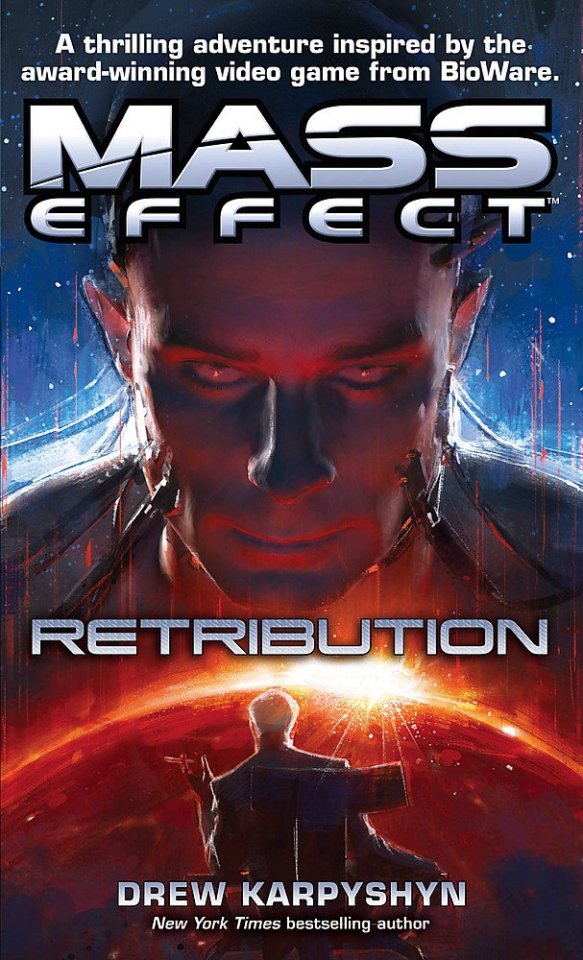
Mass Effect Retribution is the third book in the official Mass Effect trilogy by author Drew Karpyshyn, who happens to also be Lead Writer for Mass Effect 1 and Mass Effect 2.
I didn’t expect to pick it up, because to be very honest I didn’t expect to like it. 9 years ago I borrowed Mass Effect Revelations, and I still recall the experience as underwhelming. But this fateful fall of 2020 I had money (yay) and I saw the novel on the shelf of a swedish nerd store. I guess guilt motivated me to give the author another try: guilt, because I’ve been writing a Mass Effect fanfiction for an ungodly amount of years and I’ve been deathly afraid of lore that might contradict my decisions ever since I started -but I knew this book covered elements that are core to plot elements of my story, and I was willing to let my anxiety to the door and see what was up.
Disclaimer: I didn’t reread Mass Effect Revelation before plunging into this read, and entirely skipped Ascension. So anything in relation to character introduction and continuity will have to be skipped.
Back-cover pitch (the official, unbiased, long one)
Humanity has reached the stars, joining the vast galactic community of alien species. But beyond the fringes of explored space lurk the Reapers, a race of sentient starships bent on “harvesting” the galaxy’s organic species for their own dark purpose. The Illusive Man, leader of the pro-human black ops group Cerberus, is one of the few who know the truth about the Reapers. To ensure humanity’s survival, he launches a desperate plan to uncover the enemy’s strengths—and weaknesses—by studying someone implanted with modified Reaper technology. He knows the perfect subject for his horrific experiments: former Cerberus operative Paul Grayson, who wrested his daughter from the cabal’s control with the help of Ascension project director Kahlee Sanders. But when Kahlee learns that Grayson is missing, she turns to the only person she can trust: Alliance war hero Captain David Anderson. Together they set out to find the secret Cerberus facility where Grayson is being held. But they aren’t the only ones after him. And time is running out. As the experiments continue, the sinister Reaper technology twists Grayson’s mind. The insidious whispers grow ever stronger in his head, threatening to take over his very identity and unleash the Reapers on an unsuspecting galaxy. This novel is based on a Mature-rated video game.
Global opinion (TL;DR)
I came in hoping to be positively surprised and learn a thing or two about Reapers, about Cerberus and about Aria T’loak. I wasn’t, and I didn’t learn much. What I did learn was how cool ideas can get wasted by the very nature of game novelization, as the defects are not singular to this novel but quite widespread in this genre, and how annoyed I can get at an overuse of dialogue tags. The pacing is good and the narrative structure alright: everything else poked me in the wrong spots and rubbed how the series have always handled violence on my face with cruder examples. If I was on Good Reads, I’d probably give it something like 2 stars, for the pacing, some of the ideas, and my general sympathy for the IP novel struggle.
The indepth review continue past this point, just know there will be spoilers for the series, the Omega DLC which is often relevant, and the book itself!
What I enjoyed
Drew Karpyshyn is competent in narrative structure, and that does a lot for the pacing. Things rarely drag, and we get from one event to the next seamlessly. I’m not surprised this is one of the book’s qualities, as it comes from the craft of a game writer: pacing and efficiency are mandatory skills in this field. I would have preferred a clearer breaking point perhaps, but otherwise it’s a nice little ride that doesn’t ask a lot of effort from you (I was never tempted to DNF the book because it was so easy to read).
This book is packed with intringuing ideas -from venturing in the mind of the Illusive Man to assist, from the point of view of the victim, to Grayson’s biological transformation and assimilation into the Reaper hivemind, we get plenty to be excited for. I was personally intrigued about Liselle, Aria T’loak’s secret daughter, and eager to get a glimpse at the mind of the Queen Herself -also about how her collaboration with Cerberus came to be. Too bad none of these ideas go anywhere nor are being dealt with in an interesting way!!! But the concepts themselves were very good, so props for setting up interesting premices.
Pain is generally well described. It gets the job done.
I liked Sanak, the batarian that works as a second to Aria. He’s not very well characterized and everyone thinks he’s dumb (rise up for our national himbo), even though he reads almost smarter than her on multiple occasions, but I was happy whenever he was on the page, so yay for Sanak. But it might just be me having a bias for batarians.
Cool to have Kai Leng as a point of view character. I wasn’t enthralled by what was done with it, as he remains incredibly basic and as basically hateable and ungrounded than in Mass Effect 3 (I think he’s very underwhelming as a villain and he should have been built up in Mass Effect 2 to be effective). But there were some neat moments, such as the description of the Afterlife by Grayson who considers it as tugging at his base instincts, compared to Leng’s description of it where everything is deemed disgusting. The execution is not the best, but the concept was fun.
Pre-Reaperification Paul Grayson wasn’t the worst point of view to follow. I wasn’t super involved in his journey and didn’t care when he died one way or the other, but I empathized with his problems and hoped he would find a way out of the cycle of violence. The setup of his character arc was interesting, it’s just sad that any resolution -even negative- was dropped to focus on Reapers and his relationship with Kahlee Sanders, as I think the latter was the least interesting part.
The cover is cool and intringuing. Very soapy. It’s my favorite out of all the official novels, as it owns the cheesier aspect of the series, has nice contrasts and immediately asks questions. Very 90s/2000s. It’s great.
You may notice every thing I enjoyed was coated in complaints, because it’s a reflection of my frustration at this book for setting up interesting ideas and then completely missing the mark in their execution. So without further due, let’s talk about what I think the book didn’t do right.
1. Dumb complaints that don’t matter much
After reading the entire book, I am still a bit confused at to why Tim (the Illusive Man’s acronym is TIM in fandom, but I find immense joy in reffering to him as just Tim) wants his experimentation to be carried out on Grayson specifically, especially when getting to him is harder than pretty much anyone else (also wouldn’t pushing the very first experiments on alien captives make more sense given it’s Cerberus we’re talking about?). It seem to be done out of petty revenge, which is fine, but it still feels like quite the overlook to mess with a competent fighter, enhance him, and then expect things to stay under control (which Tim kind of doesn’t expect to, and that’s even weirder -why waste your components on something you plan to terminate almost immediately). At the same time, the pettiness is the only characterization we get out of Tim so good I guess? But if so, I wished it would have been accentuated to seem even more deliberate (and not have Tim regret to see it in himself, which flattens him and doesn’t inform the way he views the world and himself -but we’ll get to that).
I really disliked the way space travel is characterized. And that might be entirely just me, and perhaps it doesn’t contradict the rest of the lore, but space travel is so fast. People pop up left and right in a matter of hours. At some point we even get a mention of someone being able to jump 3 different Mass Relays and then arrive somewhere in 4 hours. I thought you first had to discharge your ship around a stellar object before being able to engage in the next jump (and that imply finding said object, which would have to take more than an hour). It’s not that big of a deal, but it completely crammed this giant world to a single boulevard for me and my hard-science-loving tastes. Not a big deal, but not a fan at all of this choice.
You wouldn’t believe how often people find themselves in a fight naked or in their underwear. It happens at least 3 times (and everyone naked survives -except one, we’ll get to her later).
Why did I need to know about this fifteen year’s old boner for his older teacher. Surely there were other ways to have his crush come across without this detail, or then have it be an actual point of tension in their relationship and not just a “teehee” moment. Weird choice imo.
I’m not a fan of the Talons. I don’t find them interesting or compelling. There is nothing about them that informs us on the world they live in. The fact they’re turian-ruled don’t tell us anything about turian culture that, say, the Blue Suns don’t tell us already. It’s a generic gang that is powerful because it is. I think they’re very boring, in this book and in the Omega DLC alike (a liiittle less in the DLC because of Nyreen, barely). Not a real criticism, I just don’t care for them at all.
I might just be very ace, but I didn’t find Anderson and Kahlee Sanders to have much chemistry. Same for Kahlee and Grayson (yes we do have some sort of love-triangle-but-not-really, but it’s not very important and it didn’t bother me much). Their relationships were all underwhelming to me, and I’ll explain why in part 4.
The red sand highs are barely described, and very safely -probably not from a place of intimate knowledge with drugs nor from intense research. Addiction is a delicate topic, and I feel like it could have been dealt with better, or not be included at all.
There are more of these, but I don’t want to turn this into a list of minor complaints for things that are more a matter of taste than craft quality or thematic relevance. So let’s move on.
2. Who cares about aliens in a Mass Effect novel
Now we’re getting into actual problems, and this one is kind of endemic to the Mass Effect novels (I thought the same when I read Revelation 9 years ago, though maybe less so as Saren in a PoV character -but I might have forgotten so there’s that). The aliens are described and characterized in the most uncurious, uninspired manner. Krogans are intimidating brutes. Turians are rigid. Asaris are sexy. Elcors are boring. Batarians are thugs (there is something to be said with how Aria’s second in command is literally the same batarian respawned with a different name in Mass Effect 2, this book, then the Omega DLC). Salarians are weak nerds. (if you allow me this little parenthesis because of course I have to complain about salarian characterization: the only salarian that speaks in the book talks in a cheap ripoff of Mordin’s speech pattern, which sucks because it’s specific to Mordin and not salarians as a whole, and is there to be afraid of a threat as a joke. This is SUCH a trope in the original trilogy -especially past Mass Effect 1 when they kind of give up on salarians except for a few chosen ones-, that salarians’ fear is not to be taken seriously and the only salarians who are to be considered don’t express fear at all -see Mordin and Kirrahe. It happens at least once per game, often more. This is one of the reasons why the genophage subplot is allowed to be so morally simple in ME3 and remove salarians from the equation. I get why they did that, but it’s still somewhat of a copeout. On this front, I have to give props to Andromeda for actually engaging with violence on salarians in a serious manner. It’s a refreshing change) I didn’t learn a single thing about any of these species, how they work, what they care about in the course of these 79750 words. I also didn’t learn much about their relationships to other species, including humans. I’ll mention xenophobia in more details later, but this entire aspect of the story takes a huge hit because of this lack of investment of who these species are.
I’ve always find Mass Effect, despite its sprawling universe full of vivid ideas and unique perspectives, to be strangely enamoured with humans, and it has never been so apparent than here. Only humans get to have layers, deserving of empathy and actual engagement. Only their pain is real and important. Only their death deserve mourning (we’ll come back to that). I’d speculate this comes from the same place that was terrified to have Liara as a love interest in ME1 in case she alienated the audience, and then later was surprised when half the fanbase was more interested in banging the dinosaur-bird than their fellow humans: Mass Effect often seem afraid of losing us and breaking our capacity for self-projection. It’s a very weird concern, in my opinion, that reveals the most immature, uncertain and soapy parts of the franchise. Here it’s punched to eleven, and I find it disappointing. It also have a surprising effect on the narrative: again, we’ll come back to that.
3. The squandered potential of Liselle and Aria
Okay. This one hurts. Let’s talk about Liselle: she’s introduced in the story as a teammate to Grayson, who at the time works as a merc for Aria T’loak on Omega, and also sleeps with him on the regular. She likes hitting the Afterlife’s dancefloor: she’s very admired there, as she’s described as extremely attractive. One night after receiving a call from Grayson, she rejoins him in his apartment. They have sex, then Kai Leng and other Cerberus agents barge in to capture Grayson -a fight break out (the first in a long tradition of naked/underwear fights), and both of them are stunned with tranquilizers. Grayson is to be taken to the Illusive Man. Kai Leng decides to slit Liselle’s throat as she lays unconscious to cover their tracks. When Aria T’loak and her team find her naked on a bed, throat gaping and covered in blood, Liselle is revealed, through her internal monologue, to be Aria’s secret daughter -that she kept secret for both of their safety. So Liselle is a sexpot who dies immediately in a very brutal and disempowered manner. This is a sad way to handle Aria T’loak’s daughter I think, but I assume it was done to give a strong motivation to the mother, who thinks Grayson did it. And also, it’s a cool setup to explore her psyche: how does she feel about business catching up with her in such a personal manner, how does she feel about the fact she couldn’t protect her own offspring despite all her power, what’s her relationship with loss and death, how does she slip when under high emotional stress, how does she deal with such a vulnerable position of having to cope without being able to show any sign of weakness... But the book does nothing with that. The most interesting we get is her complete absence of outward reaction when she sees her daughter as the centerpiece of a crime scene. Otherwise we have mentions that she’s not used to lose relatives, vague discomfort when someone mentions Liselle might have been raped, and vague discomfort at her body in display for everyone to gawk at. It’s not exactly revelatory behavior, and the missed potential is borderline criminal. It also doesn’t even justify itself as a strong motivation, as Aria vaguely tries to find Grayson again and then gives up until we give her intel on a silver platter. Then it almost feels as if she forgot her motivation for killing Grayson, and is as motivated by money than she is by her daughter’s murder (and that could be interesting too, but it’s not done in a deliberate way and therefore it seems more like a lack of characterization than anything else).
Now, to Aria. Because this book made me realize something I strongly dislike: the framing might constantly posture her as intelligent, but Aria T’loak is... kind of dumb, actually? In this book alone she’s misled, misinformed or tricked three different times. We’re constantly ensured she’s an amazing people reader but never once do we see this ability work in her favor -everyone fools her all the time. She doesn’t learn from her mistakes and jump from Cerberus trap to Cerberus trap, and her loosing Omega to them later is laughably stupid after the bullshit Tim put her through in this book alone. I’m not joking when I say the book has to pull out an entire paragraph on how it’s easier to lie to smart people to justify her complete dumbassery during her first negotiation with Tim. She doesn’t seem to know anything about how people work that could justify her power. She’s not politically savvy. She’s not good at manipulation. She’s just already established and very, very good at kicking ass. And I wouldn’t mind if Aria was just a brutish thug who maintains her power through violence and nothing else, that could also be interesting to have an asari act that way. But the narrative will not bow to the reality they have created for her, and keep pretending her flaw is in extreme pride only. This makes me think of the treatment of Sansa Stark in the latest seasons of Game of Thrones -the story and everyone in it is persuaded she’s a political mastermind, and in the exact same way I would adore for it to be true, but it’s just... not. It’s even worse for Aria, because Sansa does have victories by virtue of everyone being magically dumber than her whenever convenient. Aria just fails, again and again, and nobody seem to ever acknowledge it. Sadly her writing here completely justifies her writing in the Omega DLC and the comics, which I completely loathe; but turns out Aria isn’t smart or savvy, not even in posture or as a façade. She’s just violent, entitled, easily fooled, and throws public tantrums when things don’t go her way. And again, I guess that would be fine if only the narrative would recognize what she is. Me, I will gently ignore most of this (in her presentation at least, because I think it’s interesting to have something pitiful when you dig a little) and try to write her with a bit more elevation. But this was a very disappointing realization to have.
4. The squandered potential of Grayson and the Reapers
The waste of a subplot with Aria and Liselle might have hurt me more in a personal way, but what went down between Grayson and the Reapers hurts the entire series in a startling manner. And it’s so infuriating because the potential was there. Every setpiece was available to create something truly unique and disturbing by simply following the series’ own established lore. But this is not what happens. See, when The Illusive Man, our dearest Tim, captures Grayson for a betrayal that happened last book (something about his biotic autistic daughter -what’s the deal with autistic biotics being traumatized by Cerberus btw), he decides to use him as the key part of an experiment to understand how Reapers operate. So he forcefully implants the guy with Reaper technology (what they do exactly is unclear) to study his change into a husk and be prepared when Reapers come for humanity -it’s also compared to what happened with Saren when he “agreed” to be augmented by Sovereign. From there on, Grayson slowly turns into a husk. Doesn’t it sound fascinating, to be stuck in the mind of someone losing themselves to unknowable monsters? If you agree with me then I’m sorry because the execution is certainly... not that. The way the author chooses to describe the event is to use the trope of mind control used in media like Get Out: Grayson taking the backseat of his own mind and body. And I haaaaate it. I hate it so much. I don’t hate the trope itself (it can be interesting in other media, like Get Out!), but I loathe that it’s used here in a way that totally contradicts both the lore and basic biology. Grayson doesn’t find himself manipulated. He doesn’t find himself justifying increasingly jarring actions the way Saren has. He just... loses control of himself, disagreeing with what’s being done with him but not able to change much about it. He also can fight back and regain control sometimes -but his thoughts are almost untainted by Reaper influence. The technology is supposed to literally replace and reorganize the cells of his body; is this implying that body and mind are separated, that there maybe exists a soul that transcends indoctrination? I don’t know but I hate it. This also implies that every victim of the Reaper is secretely aware of what they’re doing and pained and disagreeing with their own actions. And I’m sorry but if it’s true, I think this sucks ass and removes one of the creepiest ideas of the Mass Effect universe -that identity can and will be lost, and that Reapers do not care about devouring individuality and reshaping it to the whims of their inexorable march. Keeping a clear stream of consciousness in the victim’s body makes it feel like a curse and not like a disease. None of the victims are truly gone that way, and it removes so much of the tragic powerlessness of organics in their fight against the machines. Imagine if Saren watched himself be a meanie and being like “nooo” from within until he had a chance to kill himself in a near-victorious battle, compared to him being completely persuaded he’s acting for the good of organic life until, for a split second, he comes to realize he doesn’t make any sense and is loosing his mind like someone with dementia would, and needs to grasp to this instant to make the last possible thing he could do to save others and his own mind from domination. I feel so little things for Saren in the former case, and so much for the latter. But it might just be me: I’m deeply touched by the exploration of how environment and things like medication can change someone’s behavior, it’s such a painfully human subject while forceful mind control is... just kind of cheap.
SPEAKING OF THE REAPERS. Did you know “The Reapers” as an entity is an actual character in this book? Because it is. And “The Reapers” is not a good character. During the introduction of Grayson and explaining his troubles, we get presented with the mean little voice in his head. It’s his thoughts in italics, nothing crazy, in fact it’s a little bit of a copeout from actually implementing his insecurities into the prose. But I gave the author the benefit of the doubt, as I knew Grayson would be indoctrinated later, and I fully expected the little voice to slowly start twisting into what the Reapers suggested to him. This doesn’t happen, or at least not in that slowburn sort of way. Instead the little voice is dropped almost immediately, and the Reapers are described, as a presence. And as the infection progresses, what Grayson do become what the Reapers do. The Reapers have emotions, it turns out. They’re disgusted at organic discharges. They’re pleased when Grayson accomplish what they want, and it’s told as such. They foment little plans to get their puppet to point A to point B, and we are privy to their calculations. And I’m sorry but the best way to ruin your lovecraftian concept is to try and explain its motivations and how it thinks. Because by definition the unknown is scarier, smarter, and colder than whatever a human author could come up with. I couldn’t take the Reapers’ dumb infiltration plans seriously, and now I think they are dumb all the time, and I didn’t want to!! The only cases in which the Reapers influence Grayson, we are told in very explicit details how so. For example, they won’t let Grayson commit suicide by flooding his brain with hope and determination when he tries, or they will change the words he types when he tries to send a message to Kahlee Sanders. And we are told exactly what they do every time. There was a glorious occasion to flex as a writer by diving deep into an unreliable narrator and write incredibly creepy prose, but I guess we could have been confused, and apparently that’s not allowed. And all of this is handled that poorly becauuuuuse...
5. Subtext is dead and Drew killed it
Now we need to talk about the prose. The style of the author is... let’s be generous and call it functional. It’s about clarity. The writing is so involved in its quest for clarity that it basically ruins the book, and most of the previous issues are direct consequences of the prose and adjacent decisions.The direct prose issues are puzzling, as they are known as rookie technical flaws and not something I would expect from the series’ Lead Writer for Mass Effect 1 and 2, but in this book we find problems such as:
The reliance on adverbs. Example: "Breathing heavily from the exertion, he stood up slowly”. I have nothing about a well-placed adverb that gives a verb a revelatory twist, but these could be replaced by stronger verbs, or cut altogether.
Filtering. Example: “Anderson knew that the fact they were getting no response was a bad sign”. This example is particularly egregious, but characters know things, feel things, realize things (boy do they realize things)... And this pulls us away from their internal world instead of making us live what they live, expliciting what should be implicit. For example, consider the alternative: “They were getting no reponse, which was a bad sign in Anderson’s experience.” We don’t really need the “in Anderson’s experience” either, but that already brings us significantly closer to his world, his lived experience as a soldier.
The goddamn dialogue tags. This one is the worst offender of the bunch. Nobody is allowed to talk without a dialogue tag in this book, and wow do people imply, admit, inform, remark and every other verb under the sun. Consider this example, which made me lose my mind a little: “What are you talking about? Kahlee wanted to know.” I couldn’t find it again, but I’m fairly certain I read a “What is it?” Anderson wanted to know. as well. Not only is it very distracting, it’s also yet another way to remove reader interpretation from the equation (also sometimes there will be a paragraph break inside a monologue -not even a long one-, and that doesn’t seem to be justified by anything? It’s not as big of a problem than the aversion to subtext, but it still confused me more than once)
Another writing choice that hurts the book in disproportionate ways is the reliance on point of view switches. In Retribution, we get the point of view of: Tim, Paul Grayson, Kai Leng, Kahlee Sanders, David Anderson, Aria T’loak, and Nick (a biotic teenager, the one with the boner). Maybe Sanak had a very small section too, but I couldn’t find it again so don’t take my word for it. That’s too many point of views for a plot-heavy 80k book in my opinion, but even besides that: the point of view switch several times in one single chapter. This is done in the most harmful way possible for tension: characters involved in the same scene take turns on the page explaining their perspective about the events, in a way that leaves the reader entirely aware of every stake to every character and every information that would be relevant in a scene. Take for example the first negotiation between Aria and Tim. The second Aria needs to ponder what her best move could possibly be, we get thrown back into Tim’s perspective explaining the exact ways in which he’s trying to deceive her -removing our agency to be either convinced or fooled alongside her. This results in a book that goes out of his way to keep us from engaging with its ideas and do any mental work on our own. Everything is laid out, bare and as overexplained as humanly possible. The format is also very repetitive: characters talk or do an action, and then we spend a paragraph explaining the exact mental reasoning for why they did what they did. There is nothing to interpret. No subtext at all whatsoever; and this contributes in casting a harsh light on the Mass Effect universe, cheapening it and overtly expliciting some of its worst ideas instead of leaving them politely blurred and for us to dress up in our minds. There is only one theme that remains subtextual in my opinion. And it’s not a pretty one.
6. Violence
So here’s the thing when you adapt a third person shooter into a novel: you created a violent world and now you will have to deal with death en-masse too (get it get it I’m so sorry). But while in videogames you can get away with thoughtless murder because it’s a gameplay mechanic and you’re not expected to philosophize on every splatter of blood, novels are all about internalization. Violent murder is by definition more uncomfortable in books, because we’re out of gamer conventions and now every death is actual when in games we just spawned more guys because we wanted that level to be a bit harder and on a subconscious level we know this and it makes it somewhat okay. I felt, in this book, a strange disconnect between the horrendous violence and the fact we’re expected to care about it like we would in a game: not much, or as a spectacle. Like in a game, we are expected to root for the safety of named characters the story indicated us we should be invested in. And because we’re in a book, this doesn’t feel like the objective truth of the universe spelled at us through user interface and quest logs, but the subjective worldview of the characters we’re following. And that makes them.... somewhat disturbing to follow.
I haven’t touched on Anderson and Kahlee Sanders much yet, but now I guess I have too, as they are the worst offenders of what is mentioned above. Kahlee cares about Grayson. She only cares about Grayson -and her students like the forementioned Nick, but mostly Grayson. Grayson is out there murdering people like it’s nobody’s business, but still, keeping Grayson alive is more important that people dying like flies around him. This is vaguely touched on, but not with the gravitas that I think was warranted. Also, Anderson goes with it. Because he cares about Kahlee. Anderson organizes a major political scandal between humans and turians because of Kahlee, because of Grayson. He convinces turians to risk a lot to bring Cerberus down, and I guess that could be understandable, but it’s mostly manipulation for the sake of Grayson’s survival: and a lot of turians die as a result. But not only turians: I was not comfortable with how casually the course of action to deal a huge blow to Cerberus and try to bring the organization down was to launch assault on stations and cover-ups for their organization. Not mass arrests: military assault. They came to arrest high operatives, maybe, but the grunts were okay to slaughter. This universe has a problem with systemic violence by the supposedly good guys in charge -and it’s always held up as the righteous and efficient way compared to these UGH boring politicians and these treaties and peace and such (amirite Anderson). And as the cadavers pile up, it starts to make our loveable protagonists... kind of self-centered assholes. Also: I think we might want to touch on who these cadavers tend to be, and get to my biggest point of discomfort with this novel.
Xenophobia is hard to write well, and I super sympathize with the attempts made and their inherent difficulty. This novel tries to evoke this theme in multiple ways: by virtue of having Cerberus’ heart and blade as point of view characters, we get a window into Tim and Kai Leng’s bigotry against aliens, and how this belief informs their actions. I wasn’t ever sold in their bigotry as it was shown to us. Tim evokes his scorn for whatever aliens do and how it’s inferior to humanity’s resilience -but it’s surface-level, not informed by deep and specific entranched beliefs on aliens motives and bodies, and how they are a threat on humanity according to them. The history of Mass Effect is rich with conflict and baggage between species, yet every expression of hatred is relegated to a vague “eww aliens” that doesn’t feed off systemically enforced beliefs but personal feelings of mistrust and disgust. I’ll take this example of Kai Leng, and his supposedly revulsion at the Afterlife as a peak example of alien decadence: he sees an asari in skimpy clothing, and deems her “whorish”. And this feels... off. Not because I don’t think Kai Leng would consider asaris whorish, but because this is supposed to represent Cerberus’ core beliefs: yet both him and Tim go on and on about how their goal is to uplift humanity, how no human is an enemy. But if that’s the case, then what makes Kai Leng call an Afterlife asari whorish and mean it in a way that’s meaningfully different from how he would consider a human sex worker in similar dispositions? Not that I don’t buy that Cerberus would have a very specific idea of what humans need to be to be considered worth preserving as good little ur-fascists, but this internal bias is never expressed in any way, and it makes the whole act feel hollow. Cerberus is not the only offender, though. Every time an alien expresses bias against humans in a way we’re meant to recognize as xenophobic, it reads the same way: as personal dislike and suspicion. As bullying. Which is such a small part of what bigotry encompasses. It’s so unspecific and divorced from their common history that it just never truly works in my opinion. You know what I thought worked, though? The golden trio of non-Cerberus human characters, and their attitude towards aliens. Grayson’s slight fetishism and suspicion of his attraction to Liselle, how bestial (in a cool, sexy way) he perceives the Afterlife to be. The way Anderson and Kahlee use turians for their own ends and do not spare a single thought towards those who died directly trying to protect them or Grayson immediately after the fact (they are more interested in Kahlee’s broken fingers and in kissing each other). How they feel disgust watching turians looting Cerberus soldiers, not because it’s disrespectful in general and the deaths are a inherent tragedy but because they are turians and the dead are humans. But it's not even really on them: the narration itself is engrossed by the suffering of humans, but aliens are relegated to setpieces in gore spectacles. Not even Grayson truly cares about the aliens the Reapers make him kill. Nobody does. Not even the aliens among each other: see, once again, Aria and Liselle, or Aria and Sanak. Nobody cares. At the very end of the story, Anderson comes to Kahlee and asks if she gives him permission to have Grayson’s body studied, the same way Cerberus planned to. It’s source of discomfort, but Kahlee gives in as it’s important, and probably what Grayson would have wanted, maybe? So yeah. In the end the only subtextual theme to find here (probably as an accident) is how the Alliance’s good guys are not that different from Cerberus it turns out. And I’m not sure how I feel about that.
7. Lore-approved books, or the art of shrinking an expanding universe
I’d like to open the conversation on a bigger topic: the very practice of game novelization, or IP-books. Because as much as I think Drew Karpyshyn’s final draft should not have ended up reading that amateur given the credits to his name, I really want to acknowledge the realities of this industry, and why the whole endeavor was perhaps doomed from the start regardless of Karpyshyn’s talent or wishes as an author.
The most jarring thing about this reading experience is as follows: I spent almost 80k words exploring this universe with new characters and side characters, all of them supposedly cool and interesting, and I learned nothing. I learned nothing new about the world, nothing new about the characters. Now that it’s over, I’m left wondering how I could chew on so much and gain so little. Maybe it’s just me, but more likely it’s by design. Not on poor Drew. Now that I did IP work myself, I have developed an acute sympathy for anyone who has to deal with the maddening contradictions of this type of business. Let me explain.
IP-adjacent media (in the West at least) sure has for goal to expand the universe: but expand as in bloat, not as in deepen. The target for this book is nerds like me, who liked the games and want more of this thing we liked. But then we’re confronted by two major competitors: the actual original media (in ME’s case, the games) whose this product is a marketing tool for, and fandom. IP books are not allowed to compete with the main media: the good ideas are for the main media, and any meaningful development has to be made in the main media (see: what happened with Kai Leng, or how everyone including me complains about the worldbuilding to the Disney Star Swars trilogy being hidden in the novelization). And when it comes to authorship (as in: taking an actual risk with the media and give it a personal spin), then we risk introducing ideas that complicate the main media even though a ridiculously small percent of the public will be attached to it, or ideas that fans despise. Of course we can’t have the latter. And once the fandom is huge enough, digging into anything the fans have strong headcanons for already risks creating a lot of emotions once some of these are made canon and some are disregarded. As much as I joke about how in Mass Effect you can learn about any gun in excrutiating details but we still don’t know if asaris have a concept for marriage... would we really want to know how/if asaris marry, or aren’t we glad we get to be creative and put our own spin on things? The dance between fandom and canon is a delicate one that can and will go wrong. And IP books are generally not worth the drama for the stakeholders.
Add this to insane deadlines, numerous parties all involved in some way and the usual struggles of book writing, and we get a situation where creating anything of value is pretty much a herculean task.
But then I ask... why do IP books *have* to be considered canon? I know this is part of the appeal, and that removing the “licenced” part only leaves us with published fanfiction, but... yeah. Yeah. I think it could be a fascinating model. Can you imagine having your IP and hiring X amount of distinctive authors to give it their own spin, not as definitive additions to the world but as creative endeavours and authorial deepdives? It would allow for these novels to be comparative and companion to the main media instead of being weird appendages that can never compare, and the structure would allow for these stories to be polished and edited to a higher level than most fanfictions. Of course I’m biased because I have a deep belief in the power of fanfiction as commentary and conversational piece. But I would really love to see companies’ approach to creative risk and canon to change. We might get Disney stuff until we die now, so the least we can ask for is for this content to be a little weird, personal and human.
That’s it. That’s the whole review. Thank you for reading, it was very long and weirdly passionate, have a nice dayyyyy.
#Mass Effect#mass effect retribution#me critical#writing#mass effect novels#anderson#kahlee sanders#Aria T'loak#paul grayson#liselle#salarians#IP conversation#omega#mass effect lore#reapers#book review
24 notes
·
View notes
Text
My Problems With X of Swords So Far....
SPOILERS!!!!!
As of this post, we are 16 of 22 chapters into this crossover event, the first of the Krakoa Era. I want to start off by saying that I have largely been enjoying this era of X-Men overall; I came for Jonathan Hickman taking over the franchise, but spent some of my quaruntine time catching up on the other titles and mostly enjoyed them. I am by no means an X-Men expert or superfan, but I know my lore pretty well and am a fan. That being said, let’s dive into this mess.
I want to give credit where credit is due, the first half of this event has been well crafted. The writers, as apparently led by Hickman and Tini Howard, have worked to create a consistent tone across all of the books and it shows. This is clearly an event crafted with care and skill. And aside from the error on Bogdanovic’s part, the art teams have been on point delivering great looking books. Considering this, the pedigree of the teams, and again, Jonathan Hickam, the guy who Marvel trusted to end Stan and Jack’s creation in Secret Wars, leading this event- this is should by all measures be much better than it is. Even if it didn’t live up to the aforementioned event, it should still be better than what we’ve got because of the ideas we’ve got on the page. I think these are all interrelated problems with the event, but I’m going to list them individually as I see them.
The Problems
1. Pacing- This largely effects the first half of the event, considering how the backhalf has changed, but we spent nearly 10 issues of the X-Men simply gathering their prophosized swords as ruled by the host of the tournament between the two sides, Saturynye. During this time, we did not get a lot of ideas of strategy or spycraft to learn more about a largely unknown enemy. We got a lot of decompressed character introspection, and even a set up to Al Ewing’s upcoming SWORD book (looking majorly forward to that book). This meant that we didn’t learn a lot about these characters that we did not already know to try to drive up the emotional tension that I don’t believe worked as the internal stakes did not match the scale of the external threats- the end of a utopia. This might have worked more if there were less of it and thus getting right to the heart of the matter. But the event spent so much space on spinning it’s wheels for.....what reason? Why was it necessary to give so much time this aspect compared to other possibilities? This brings me to my next problem.
2. The Promise of the New- One of the great things about this event is how it rewrites what we know about Apocalypse to make him more interesting while giving us a huge new set of characters and lore to get to know and love with the revelation of a whole secret history of mutants on Earth and then the history of the exiled mutants to what basically amounts to a Hell after fending it off from taking over Earth. It’s genuinely a great addition to Apocalypse and the franchise as a whole. I am supremely excited about the future of the Arrako people, but we spent 10 issues of the X-Men gathering swords while learning very little about this new land and new people. We learned about Solem a little bit and how he relates to the rest of Arrako, but that’s basically it. We are 16 issues in and we don’t know a whole lot about this lands or even more specifically the histories of Swordbreakers of Arrako. We know a little, but in all that time where the characters of X-Men and Arrako could have been interacting and building relationships to actually have drama beyond one side is coming to dominate the Earth for ancient reasons, we got next to nothing. And even as the tournament has started, the information and drama between the new side is minimal; enough to make the move the narrative forward but that’s it. I’m not saying I need a whole history course, but I definitely feel like we should know more than we do know about Arrako. I think we’ve in fact learned more about Otherworld than Arrako, which brings me to my next problem.
3. Otherworld....Why?- Seriously, why? It’s pretty clear both before and after Secret Wars that it isn’t necessary to travel through Otherworld to travel the multiverse. So...why? Because they want to build up Otherworld as a new playground for future stories and to connect othe ongoing drama of what had been happening in Excalibur, which...ok. Look I get that it helps to develop long unused properties to breath new life into them, but what does Otherworld have to do with Arrako other than apparently you have to travel through it to get to it? That seems forced to me and it does nothing to heighten the drama of the battle between Krakoa and Arrako. It forces a war to become a tournament, but other than that....again, it really doesn’t add anything. Otherworld’s role in this story is completely unnecessary. It’s easy to imagine this story without Otherworld. If Otherworld played a less forced role and a role that made more sense to the conflict, I wouldn’t have a problem with it’s inclusion or learning as much as we have about it. But, we’ve been given more information about various parts of Otherworld that have not been important and we could have spent that time learning more about or developing the relationships of Arrako/Krakoa.
4. A Tournament of the Absurd- I know I complained about it taking ten issues just to get our two sides into the same room for conflict, but then it took another three before we got to our first conflict. We were over half way through the crossover and no one had drawn their sword against their would-be enemy in favor of an overly theatrical and long dinner where we finally got some relationship building but were still not at the main draw of this attraction- the duels or whatever type of conflict it would really turn out to be. Literrally anything that involved the swords being used for combat got pushed back until like 60% through this story, which is squandering the promise of the premise. But finally, this week get got the to the action, and it was nothing like anticipated. Our first match lasts less 3 pages, which could be exciting if we understood what was going on with how the nature of the loss, but then it ‘s undercut by a plot point that makes very little sense and does not give the characters involved any real agency. An unexpected romance or marriage is always a nice surprise in a story like this, but this crossover doesn’t earn it. The characters are literally whisked away against their wills and told to marry each other without knowing a thing about each other, nor can they communicate with each other. If the marriage was a solution because of the two sides coming to an arrangement by the two sides talking it over or if it had been the two newlyweds plan based on their own insights and choices, then this idea would have been wonderful. But again, literally taken against their wills without warning and forced to marriage for the sake of two societies without it even being clear that this really advanced the cause of or guarnteed the safety of either side. Then we move forward to a fight that has promise only to be immediately stopped from fighting to participate in a childish contest between two obviously mismatched opponents that makes the contest one sided. Like, What The Actual Fuck? Why avoid the fight in favor of that contest? One clearly has more entertainment value than the other. Fuck it, fine, let’s see if Wolverine is given a fun fight. His first match (yeah, we’re getting too much Logan here) has potential, but the creative team decides to make the fight more psychedlic to the detriment of clarity of choreography and thus removes tension. It’s a style choice that pulls away from the fight and then the victory is undermined by a bullshit twist of the rules that compounds the lack of clarity into greater frustration. Then Wolverine is transported to a drinking contest against a teammate? Like, why? What does this do for the story? There’s a brief line used to justify it and the next thing it sets up, but it’s weak. It’s fucking frustrating, because developing the relationship of these two characters could have easily been handled differently rather than wasting one of the spots in the tournament for a point that is given instead of earned. I will give the third match a pass as that was actually what the story promised; intrigue and violence between the players.
At this point, unless something major changes, I’m calling it here: X of Swords is bad. It wastes is promised premise, it wastes it’s time, and it wastes it’s potential. The problem is that this is clearly crafted by people who generally know what the hell they’re doing, but for some ungodly reason their talents are not being put to their fullest. We’ve seen all of them write better stories; heck, the ongoing stories before the crossover started were better. Even if something major happens to really hook me back into this story that will only change my opinion from bad to mediocre because we’re already 75-ish% done with story, and that means all these problems will always be true. I really hope the characters of Arrako stick around after this story, because I think they have immense potential, but this is just a bad start. I know there are people out there that are happy with this story, and I’m happy for them. But, I hope I am not alone in seeing these problems. Let me know if I am not alone.
7 notes
·
View notes
Text
Anyways buckle down folks this has been sitting in my head ever since I started seeing spoilers about the identities of the zodiac heroes that have been revealed in Season 3
Click below on why I think Marc Anciel will get a miraculous in season 4/5 and what I will predict it will be (Spoilers for everything up to Party Crasher and Ikari Gozen):
The first and obvious piece of evidence that would lend some form of credibility to this theory is based off of the number of confirmed (and shown) miraculouses in the show vs the number of eligible users. As of season 3, we know that there are 19 miraculouses in Paris: The Ladybug and Black Cat, The 2nd-tier Miraculouses (Bee, Fox, and Turtle as well as the Butterfly and Peacock), and the 12 Zodiac miraculouses (Rat, Ox, tiger, rabbit, dragon, snake, horse, goat, monkey, rooster, dog, and pig). Take away 2 of them (the Butterfly and Peacock as they go to Gabriel and Nathalie) and you are left with 17 miraculouses that can be given to new heroes.

As we have seen from past episodes, Ladybug tends to appoint new heroes based off of who she is close with and can trust as well as who is best fit for the task at hand. So far, the people Ladybug has appointed as heroes have all been Marinette’s friends (or her peers), and given that this is also a kid’s show designed to cater to and be relatable to kids, it would stand to reason that ALL of the new heroes would be around Marinette’s age. In addition, in “Timetagger”, Older!Alix also talks about there being a TEAM of superheroes in the future, which presents plenty of opportunity to explore the lore of the show through each Kwami and their powers and what better way to do that then to add new superheroes to the Miraculous team (plus it would be a waste to see some miraculouses be used but not all of them over the course of the show, even if some light is shed on past heroes in history).
Back to the math: There are 17 miraculouses, and 15 members of Madame Bustier’s class (including Lila), plus recurring students like Luka, Kagami, and Marc, totalling to 18 candidates for kwamis. As “Ikari Gozen” and “Party Crasher” confirmed, Kagami and Luka both get Miraculouses, leaving 15 to be distributed amongst Marinette’s peers and classmates. The Cat, Ladybug, Fox, Turtle, and Bee miraculouses were all accounted for with Adrien, Marinette, Alya, Nino and Chloe, leaving a total of ten left. Alix, Kim and Max were confirmed to be Zodiac heroes of the Rabbit, Monkey, and Horse, respectively. This leaves 7 miraculouses remaining, and 8 potential candidates.
Now this is where the theory and predictions of who will get what remaining miraculouses occurs.
If you go off of the popular fan theory that the girls of the class will each get a miraculous (Which many had used to predict Alya and Alix’s miraculous holder statuses so would hold more weight as a basis for a theory), the remaining girls in the photo, Juleka, Mylene and Rose, will each respectively get the Tiger, Rat, and Pig miraculouses. I know it’s confirmed through reference image leaks posted by Jeremy Zag that Marinette will be a temporary wielder of the Rat miraculous, but that is just that: Temporary. Marinette is Primarily the Ladybug holder and as such if given the chance (which is certain there will be), she will gladly give it to someone else who can use it to assist her in saving the day.

Many a Fan theorist will also suggest that Sabrina, due to her immense personality trait of her loyalty to Chloe, will be a shoe-in for the Dog Miraculous.
This now just leaves Ivan, Nathaniel, Lila, and Marc and the Ox, Rooster, and Goat miraculouses to be distributed amongst them.
As stated earlier, we’ve seen that Ladybug appoints new heroes based off of people she knows she can trust from her civilian life (with the exceptions of Queen Bee, which was an accident but one that served to better Chloe, and Kim, who Master Fu himself appointed, although I’m sure had he not given Kim a miraculous then Marinette would have anyway). With the matter of trust, we can ABSOLUTELY rule out Lila based on the virtue of her being a liar hell-bent on ruining Marinette’s life (As well as how the show seems to hint/imply her being a future villain from the end of “Timetagger” and from Lila allying herself with Gabriel which means from a plot standpoint, her being willingly given even one of the “Lesser miraculouses” like a zodiac one will be unlikely).
With Lila out of the way, that leaves an equal kwami-to-remaining-friend ratio. If one goes off of physical appearances and traits, Ivan with his size and strength would be a shoo-in for the Ox, and Nathaniel with his bright red hair and fiesty-if-you-anger-him temperament could work well with the Rooster (who could also help him learn to open up and be less shy).
That leaves Marc with the goat.
“Why Marc? Why not another recurring teenager like Aurore or Wayhem as an alternative candidate to Lila?”
It’s doubtful that Marinette even KNOWS Wayhem personally outside of being Adrien’s fanboy, and we’ve hardly seen Aurore on-screen except to have Stormy Weather be a plot vehicle for the intro episode and a recap episode, and we hve yet to see Marinette and Aurore interact in a way that would suggest that they’re actually FRIENDS and not just mere acquaintances.
MARC on the other hand, has been established in the show as being a friend of Marinette’s (as seen in “Reverser” with Marinette already showing her familiarity with him), and is also the one character outside of Madame Bustier’s class that is seen frequently hanging out with the rest of the ensemble class (as seen as being invited to the Heroes Day Picnic in “Mayura”, getting invited to test play Max’s new video game, and getting invited to Adrien’s boy’s-only party (that had initially just been amongst Adrien’s school friends).
With Marinette already being familiar enough to Marc to be friends with him and him being close enough to Nathaniel and the rest of the class to be invited to hang out with them relatively frequently, it is ABSOLUTELY plausible that Marinette would consider him to be trustworthy and enough of a team player to give him a miraculous.
“Why the Goat though?”
Marc getting the Goat miraculous would be fitting for many reasons. One of the most obvious would be the similarities in color schemes and patterns between Marc’s Reverser form and Ziggy (the goat kwami).

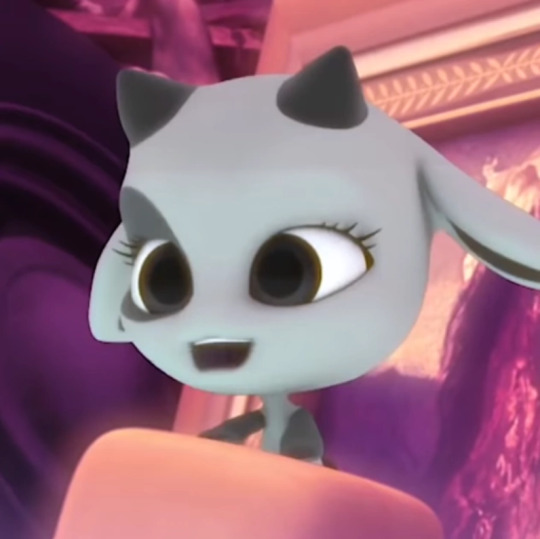
This would not be the first time that a Kwami-Holder match-up would make a callback to the holder’s past akumatization: Alix’s time travel powers as Timebreaker ended up being similar to her powers as Bunnyx, and other Kwamis like the snake, fox, and bee kwamis all design-wise had at least SOME similarity to their holders in terms of physical appearances/character designs.
Another reason, appearances aside, that a goat would be suitable for Marc is that his personality would be suitable to be matched with a goat. Goats/sheep are popularly characterized as skittish, anxious, and overall kind of shy, which are all personality traits that can be used to describe Marc. Some kwamis match their users in terms of similarity of personality, others are opposites that complement their holder’s personalities. Either way, one would agree that a goat would be very fitting personality for Marc. There is also the fact that Hope Morphin (a friend of Thomas Astruc and who was the inspiration for marc) also said on her twitter (I couldn’t find the tweet at the moment) that Marc’s favorite animal is the sheep/goat. Make of that what you will, as she could just be banking on a popular theory.
Speaking of Hope, the creators of the show, through various tweets have confirmed Marc is LGBT, and given that Marc was based on Hope, who identifies as genderfluid and bi.

That, along with Marc’s comparatively more “feminine” features (like his painted nails, his visible eyelashes and his pink-tinted lips which suggests he wears lip gloss), lends to lots of fans and show creators referring to him as “androgynous”.

Why bring up Marc’s androgyny as a point? Good question. Consider Ziggy the Kwami. Thomas Astruc confirmed in a tweet that Ziggy was named after David Bowie’s stage persona, Ziggy Stardust.

David Bowie’s “Ziggy Stardust” alter ego was FAMOUSLY known for his androgyny.
Now back to Ziggy the kwami. Another interesting feature design-wise about the goat kwami is her seemingly “feminine” features like her long eyelashes (just like a certain androgynous writer). The goat kwami, though genderless like all other kwamis, does prefer female pronouns according to the wiki. However, just because Ziggy uses feminine pronouns doesn’t automatically mean that it rules out that Marc won’t get the goat simply because he doesn’t match the “gender” of the kwami, as although most of the male miraculous holders have been given kwamis with preferred masculine pronouns, female holders like Ryukko and Rena Rouge have kwamis that use masculine pronouns. Given Marc’s androgynous design and behaviors, it wouldn’t be out of the question for him to have Ziggy as his kwami at all, On the contrary, it would be a PERFECT fit from a symbolic standpoint (and let’s face it, writers, ESPECIALLY showwriters like the miraculous ladybug team, LOVE their symbolism).
“I don’t think Marc should get a Miraculous. He’s hardly there in the story.”
We’re all entitled to our opinions and I respect yours as long as it doesn’t step on mine. Personally, I think giving characters a day in the limelight as a newly-appointed hero provides for LOTS of character-development, which is something that admittedly, most of the miracuclass could benefit from having more of. Even so, the show was confirmed for their fourth and fifth seasons, which leave plenty of episodes for which less frequently-seen-but-still-relevant-enough characters like Marc (and let’s face it, Nathaniel too) could get more episodes focusing on them. And if not, they’re still considered very good enough friends of Marinette’s and valuable and cherished members of the Miracuclass to still be considered in the running to be Zodiac heroes, especially over other characters that have even LESS story presence like Wayhem or Aurore.
#marc anciel#miraculous ladybug#miraculous ladybug theory#miraculous ladybug spoilers#please pay attention to this i spent two hours writing thus
41 notes
·
View notes
Text
The Big Fucking D&D 4E Rant
Or, ‘That Time Wizards of the Coast Fucked Up D&D’s Lore’
At the risk of raising the spectre of edition war again, I feel like it’s worth going back and exploring that time that Wizards of the Coast fucked over basically all of their lore to chase a trend that wasn’t there. Admittedly this comes with the (begrudged) acknowledgement that quite a bit of of this is likely to be out of date now that fifth edition has been out for a good several years now, but that edition has its own problems and while I’m not really going to touch upon it now, my problems with it are many and numerous.
It should be noted from the outset that this is going to talk about fourth edition in a negative and critical context, but I’m not going to be talking about the rules of the actual game as a game. This is entirely centred on story, worldbuilding and lore, and how those were handled in fourth edition as compared to what came before. That being said, if you like fourth edition, and especially if you like its lore, I would not suggest reading further.
I’m going to go far beyond being critical in this; I’m going to get outright mean.
A shout out must go to Susanna McKenzie (@cydonian-mystery) for input and feedback on this.
I suppose the most important place to start is, in many ways, the beginning, by which I mean my own introduction to Dungeons & Dragons. Mostly because it’s directly linked to the main reasons why I consider the lore to have been ruined, but before I even start off with that, I’m going to have to tell you where the lore was before I can really adequately explain its downfall.
In Realms Forgotten...
Like many people of my generation, I got into Dungeons & Dragons first through the computer based role-playing games. Specifically I started off with various titles by Black Isle and BioWare in the late-90s and early-00s, with stand-outs including Baldur’s Gate, Icewind Dale, Neverwinter Nights, and their sequels. What all of these had in common beyond being Dungeons & Dragons adaptations is the fact that they took place in the Forgotten Realms, one of the more famous settings thereof, and the lore of that world intrigued me far more than the rules alone.
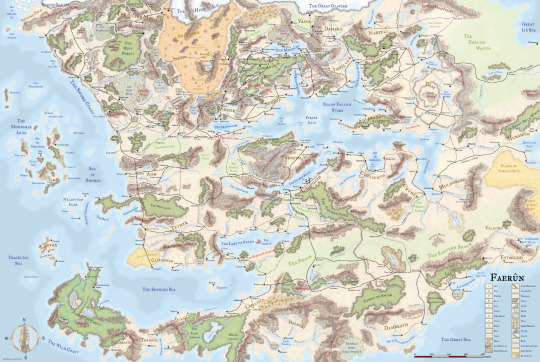
This might not sound like much, of course, to a newer fan for whom the Forgotten Realms, and its central setting of Faerûn, likely feels just like that generic world that D&D just happens to take place in nowadays. But back in the day, it was far more than that.
At the time I was getting into it, local libraries and bookstores carried bestselling novels set in the worlds in question, so I could pick up a novel based around various characters who appeared in the games, like the drow ranger Drizzt Do’Urden or the powerful wizard Elminster. There was also this huge encyclopedic book of geography and deities and the history of the world, with a big fold-out map which is still stuck up on my bedroom wall even after moving house three times. It was perfect fodder for my young nerdy fangirl self to develop full-on special interests in this stuff.
And the level of detail and lore and nuance in the world and its peoples was immense, with even the tiny and obscure bits of the setting earning massive amounts of unique lore. The result was a world that felt like it was alive, vibrant, and lived-in. Like real people could live there, with colourful heroes and villains to encounter.
This, I think, was the unwitting downfall of the Forgotten Realms, but I’m getting ahead of myself because this is really only step one, and Realms are really only one part of it. There are in total three of them, and I’ll be going through the baselines of each of them before we move on.
Out to Planescape
If you’ve read through the core books for fifth edition, there’s a chance you already have some degree of knowledge of Planescape and what it is. Or more precisely you know about the core structure of the Dungeons & Dragons multiverse; the Great Wheel. A series of elemental inner planes and transitive planes, with a ring of sixteen aligned outer planes representing various combinations derived from the axes of law versus chaos, and good versus evil, centred around a neutrally-aligned central plane.
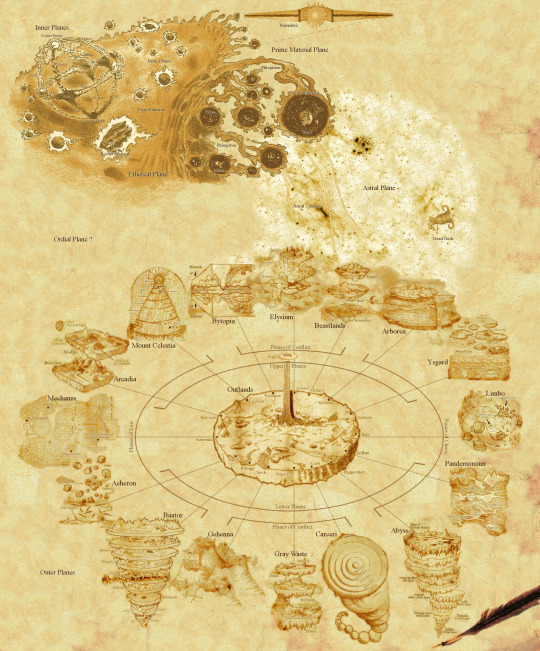
At the centre of this central plane is an infinitely tall spire, atop which lies the famous torus-shaped city of Sigil, the city at the centre of the multiverse. There are a few more bits to it than that, and there are actually differences between how it once was and how it now is. For instance back in the day, there was no such thing as the Feywild or Shadowfell, and neither one was present in the original structure as laid out in 1987’s Manual of the Planes for AD&D.
Once again, to say that this is barely scratching the surface of the planar cosmology and its general meaning to Dungeons & Dragons lore would be a gross understatement. It wasn’t long after the publication of the above book that there was a new campaign setting created called Planescape, which would centre entirely upon this cosmology and build it into the lore. This is where the city of Sigil was introduced, a place of weird concordance where demons, angels, and creatures far, far stranger than either rubbed shoulders in the street, and only the watchful eye of the mysterious and powerful Lady of Pain kept things from erupting into all-out war.
It was a world of disputes, where a myriad of factions representing various philosophical concepts went toe-to-toe with one another. All wrapped up in a tone not unlike a strange mix of China Miéville and Charles Dickens, with the local dialect and thieves cant giving a unique flavour that no major campaign world outside of Planescape can really manage.
Perhaps the most famous and lasting contribution that this setting has was the tieflings, aasimar, and genasi, referred to collectively as the planetouched. These were born from a mix of planar interaction with human bloodlines, in particular through the very old fashioned way that any hybrid is created, which is perhaps why tieflings were the more common. They carried the blood of fiends, and most commonly demons by way of ancestors who reproduced with succubi and incubi, though no two tieflings looked especially alike, with variable and strange features.
I’ll be getting back to these later, but suffice it to say that Planescape was an interesting outlier setting, far stranger and more creative than almost anything else in anyone’s catalogue. And it forms the second part of our list of ruined lore.
And back down to Greyhawk
There’s a very good chance that your knowledge of Greyhawk is pretty limited, because while one could make good arguments for the above only just being ruined when fourth edition came around, there’s a lot to be said about how Greyhawk’s been the forgotten cousin for a while now, though to the credit of the current staff at Wizards of the Coast, they did just release a full-on Greyhawk adventure with Ghosts of Saltmarsh.
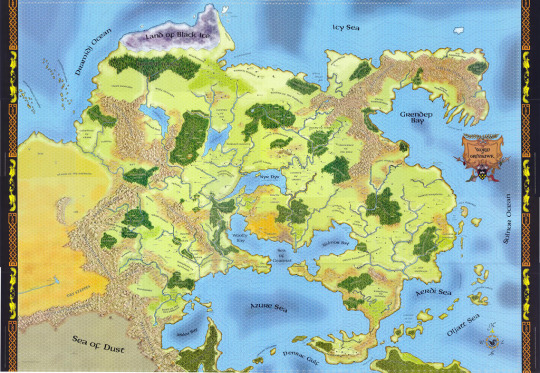
Introduced in the late seventies and early eighties, the World of Greyhawk, taking place on the fictional planet of Oerth and in particular on the subcontinent of the Flanaess, was the personally created campaign setting of Gary Gygax himself. While not as detailed as the Forgotten Realms, nor as interestingly out-there as Planescape, it is nonetheless a pretty cool world overall with a fun pulpy atmosphere that gives it its own sense of weight and nuance.
However, after Gary Gygax left TSR back in the 1980s, some later creators took it upon themselves to more or less mock his legacy overall. Nonetheless it remains a popular location for fans and creators, and towards the late third edition there was a lot of good work done in reviving it, such as with a series of adventure paths published in Dungeon Magazine in the form of Shackled City, Age of Worms, and Savage Tide, and following that a big adventure module in the form of Expedition to the Ruins of Greyhawk.
Since it’s the most basic element, let’s start with how they treated Greyhawk...
Strip-Mining the Free City
To say that Wizards of the Coast ruined Greyhawk would actually be inaccurate because, to a degree, they didn’t actually use Greyhawk. At least, not fully.
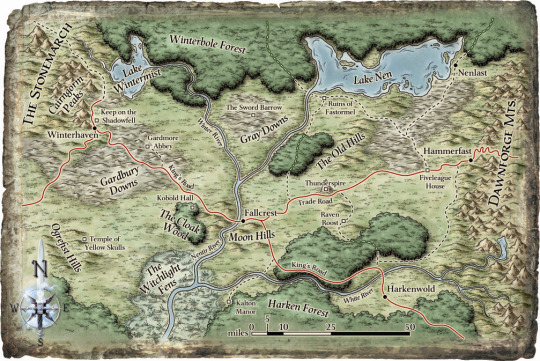
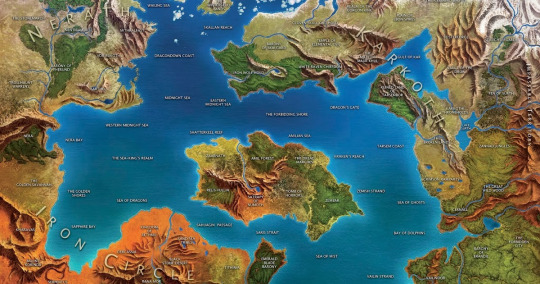
What they did instead was create a ‘new’ campaign setting, sometimes called the Nentir Vale, that used a few scavenged and cherry-picked Greyhawk deities and also a whole selection of adventures and locations previously specific to Greyhawk. Notable examples of such on the larger worldmap seen in the boardgame Conquest of Nerath included the Tomb of Horrors, the Vault of the Drow, and the Temple of Elemental Evil.
The resulting setting wasn’t Greyhawk, but had enough pieces that it felt like an insult to it. Often having those elements be modified in such a way that they felt like mockeries rather than the original concepts. A big part of why that felt like mockery is of course that Nentir Vale, or the Points of Light setting as it was sometimes referred to as, didn’t really exist as its own fully-fledged world. There wasn’t really a campaign setting book, or much detail on anything outside of a few small locations.
This is a relatively small part of what Dungeons & Dragons 4th edition did wrong, but it’s a small taste of what’s to come. However as seen with the Greyhawk conversion guidelines for many adventures, and even the release of the recent Ghosts of Saltmarsh, Greyhawk itself seems to have survived while the Nentir Vale remains almost entirely forgotten except for mentions of the Dawn War pantheon on one page of the Dungeon Master’s Guide.
It seems like Wizards of the Coast realised it was a bad idea.
‘The Great Wheel is Dead!’
As we go back out to Planescape, we notice that — much like Greyhawk — it also isn’t there, as the entire cosmology and its thematic importance has been replaced with something so radically different that it’s practically a complete replacement. Just about the only part of Planescape that was kept was Sigil itself, but as shown repeatedly in the fourth edition version of Manual of the Planes, they obviously didn’t understand either Sigil or the Great Wheel in any real way.
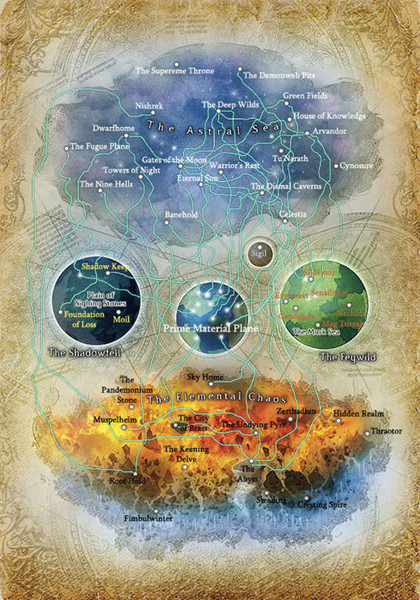
I’m not going to talk about the World Axis much in direct terms, but instead more the mindset that was taken with regards to Planescape’s Great Wheel. Now this requires something of a diversion into an old pre-fourth edition preview document, and how it handled the Great Wheel and old materials.
The Great Wheel is dead.
One of my mantras throughout the design of 4th Edition has been, “Down with needless symmetry!” The cosmology that has defined the planes of the D&D multiverse for thirty years is a good example of symmetry that ultimately creates more problems than it solves. Not only is there a plane for every alignment, there’s a plane between each alignment — seventeen Outer Planes that are supposed to reflect the characteristics of fine shades of alignment. There’s not only a plane for each of the four classic elements, there’s a Positive Energy Plane, a Negative Energy Plane, and a plane where each other plane meets — an unfortunate circumstance that has resulted in creatures such as ooze mephits.
The planes were there, so we had to invent creatures to fill them. Worse than the needless symmetry of it all, though, is the fact that many of those planes are virtually impossible to adventure in. Traversing a plane that’s supposed to be an infinite three-dimensional space completely filled with elemental fire takes a lot of magical protection and fundamentally just doesn’t sound fun. How do you reconcile that with the idea of the City of Brass, legendary home of the efreet? Why is there air in that city?
So our goals in defining a new cosmology were pretty straightforward.
• Don’t bow to needless symmetry!
• Make the planes fun for adventure!
The ‘impossible to adventure in’ mindset towards the Great Wheel is entirely bullshit, which I think is best highlighted in the passage on the City of Brass. How can a plane of pure unchanging fire without variation also have a city-state? Maybe, just maybe, it wasn’t without variation and they’re making shit up to justify their own nonsense.
The arrogance here is nothing short of infuriating. It typifies everything about the approach that Wizards of the Coast was taking towards Dungeons & Dragons at the time, and can only really be described as destructive.
There was nothing but an arrogance and often gleeful disdain for previous editions. Along with declarations of how it was so much better now, with the old version being bad for some reason despite that version having generated a huge fanbase, and a critically beloved computer role-playing game in the form of Planescape: Torment. And as with Greyhawk, they’ve done what they can to reverse that. The only elements of the new cosmology that remain are the Elemental Chaos as an in-between for the Elemental Planes, the Feywild, and the Shadowfell.
Wizards of the Coast once again seemed to realise where they were going wrong, and this is basically a recurring element of fifth edition.
Unfortunately, the World Axis and Nentir Vale aren’t really where the majority of my frustrations lie.
The Shattered Realms
To summarise the degree to which they basically destroyed the Forgotten Realms is going to take a while, simply because they were thorough. And it’s this that ultimately puts me into a position where I’m always going to be negatively predisposed towards Wizards of the Coast and their handling of Dungeons & Dragons.
As a bitof a preamble, fourth edition brought with it several substantial changes to the way a lot of the ruleset worked. And not just on a mechanical level, but on a lore level as it related to certain in-universe elements.. Basic concepts about magic and how it worked were altered at the baseline level, and in order to explain these differences it was decided by the higher-ups at Wizards of the Coast to implement a big huge event to explain the edition differences. This was something they called the Spellplague.
This is not the first time they’ve done that; they previously had the Time of Troubles, which worked to explain the relatively minor differences in magic between the first and second edition versions of Advanced Dungeons & Dragons, killed off or replaced a few gods, and ultimately shook things up a little bit. This was not really met with widespread acclaim at the time, and many complained about it but ultimately it’s a series of events which were later picked up by BioWare for Baldur’s Gate so it’s hard to really complain too harshly.
And indeed, they did it again with the change-over from fourth edition to fifth edition, with the Second Sundering bringing radical changes that all coincidentally left things looking like the pre-fourth edition version of the Forgotten Realms. Like with Planescape and Greyhawk, Wizards of the Coast knew they’d fucked up. But unlike with those, there were more than a few scars that haven’t really been all that fixable.
And to show you what I mean, I suppose we can start with the map, as that’s one of the clearest indications, when put in comparison, as to just how much was changed.
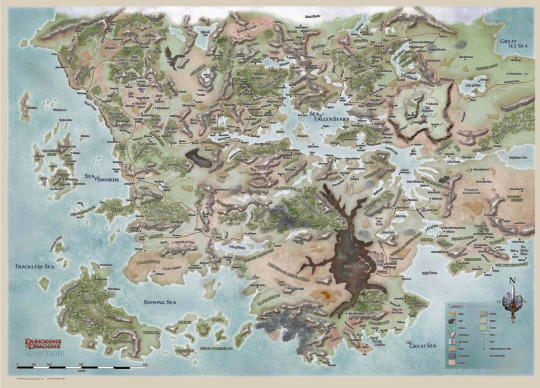
If you scroll back up and compare with the original map, you can kind of see just how much they absolutely fucked the Forgotten Realms.
The basic idea behind the Spellplague was that the goddess Mystra was murdered, and in her death throes the entirety of magic went haywire. Blue fire erupted across the world, and left entire nations and segments of the landscape scarred and destroyed. Often, conveniently, hitting worst those places that would traditionally, in-setting, be inhabited for the most part by various peoples of colour. Going into exhaustive detail would be extremely difficult, but keep in mind that the most heavily-devastated looking locations tend to be those that are inhabited by non-white people.
At least one of the nations destroyed, Halruaa, was actually the homeland of a long-running half-elf wizard character of mine at the time.
Most major magic-user characters suffered extreme maladies to their spellcasting, either killing them off or rendering them powerless.
In a series of unrelated but contemporary events, the entire elven and dwarven pantheons were radically altered. Most elven deities who weren’t Corellon Larethian were revealed to be aspects of non-elven deities, and around half of the elves themselves wound up being renamed to ‘eladrin’ to match the bullshit new elf subrace from the fourth edition books.
The drow pantheon was similarly culled until only Lolth remained, and as part of that they slew the goddess of good drow, Eilistraee. What happened to her followers is probably a good example of how there was a good deal of racism involved. Basically, the drow who followed her were ‘cleansed of the taint’ that had turned them into drow to begin with.
Including lightening their skin.
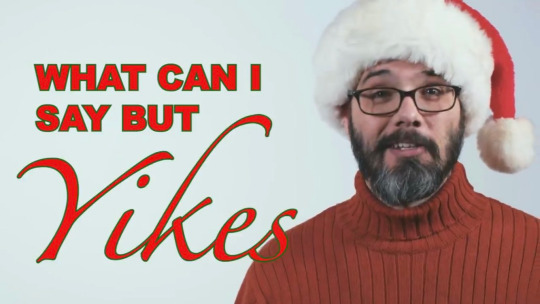
This is an event that Wizards of the Coast hasn’t really broadcast much after their reintroduction of Eilistraee, and it’s really not hard to see why they’ve minimised it.
The human gods didn’t fare much better. The entire Mulhorandi Pantheon was removed, because apparently having real-world Egyptian mythological gods around was a little too much for them. They also did the same with Tyr, who was originally from Norse mythology, though left Silvanus, Oghma, and Mielikki. Possibly because barely anyone pays attention to Celtic pantheon deities, and the latter Finnish deity was the patron goddess of a specifically popular character from the novels.
And between destroying half of the map, eliminating half of the pantheon full of various fan favourite gods, and killing off a lot of major magic-user characters, you’d think that would be considered a bad enough result.
But then there’s the timeskip.
Wizards of the Coast advanced the timeline by approximately one hundred and five years, therefore killing off literally every major human character who didn’t have some kind of magical way of extending their lifespan. And in addition to the effects of the Spellplague, brought in a variety of huge geopolitical changes that replaced major governments and kingdoms with new and nearly-unrecognisable versions that might have shared a name.
I’m not going to go into much more detail on various other changes, but keep in mind that this is only barely scratching the surface. There wasn’t a single region of the Forgotten Realms left unaltered or unmarred by this event, and it ultimately can’t be seen as anything other than an act of vandalism. It’s not even getting into the fact that, for instance, entire sections of the landscape of Toril were replaced by segments of another world entirely so they could justify the introduction of dragonborn as a core race.
Which is incidentally why I dislike the dragonborn.
The events of the fifth edition changeover worked to mitigate a lot of this, but the sheer extent of damage done is so much that the modern Forgotten Realms is still only a pale echo of its former self. All because they wanted to chase the audience of fucking World of Warcraft of all things.
Seriously, fuck Wizards of the Coast.
#4e negative#D&D 4e#the spellplague#we all get drafted into the edition war#wizards of the coast critical#wotc critical#forgotten realms#an old rant that's been a long time in the making
56 notes
·
View notes
Text
Why is Mordin Solus so relatable?, why is he so… human?: Expanded.

RESTORED POST: Expanded with extra educational content and art.
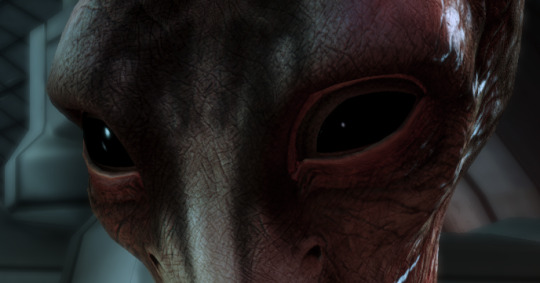
Well, the answer is really quite simple, its because he IS HUMAN.
Despite being aliens, Mass effect’s aliens……… are not exactly very alien at all. While they may look exotic, have deeply complicated lore and speak in alien voices, overall they have very VERY human characteristics just with a few weird reversals and quirks that make them appear otherworldly to us. Well most of us…

And why would this not be the case? They are after all designed by us, and they are more so reflections of ourselves to begin with.
What sets Mordin apart from other Salarians in terms of design and story? As you all should be aware by now Mordin Solus is unique in that he is essentially a Salarian transformation of his most prominent visual inspiration Clint Eastwood. Most have associated Mordin Solus’s appearance to the likeness of Bill Nye (Entirely understandable!) who also happens to be a scientist, but this is only a fan correlation based on the context of his character and superficial reading of the appearance.
J.Robert Oppenheimer.

In terms of actually being inspired by real-world scientists as stated by writer Patrick Weekes in several interviews, a key inspiration was this man J.Robert Oppenheimer the father of the atomic bomb. A fitting inspiration since both the fictional character of Mordin and the real world man J.Robert Oppenheimer aided in the development of WMDs and as a result, developed a very similar crisis of conscience once they witnessed the effects of those efforts. Mordin in particular in a very memorable conversation sights Hinduism etc when talking about how he sought comfort in religion after what happened with the genophage modification project, in an interview following the aftermath of the atomic bombing of Hiroshima Oppenheimer expressed the same sort of references to religious scripture.
youtube
youtube
https://en.wikipedia.org/wiki/J._Robert_Oppenheimer Learn more about him here.

https://en.wikipedia.org/wiki/Clint_Eastwood Learn more about the actor and director here.

In terms of actual design Clint Eastwood was the real visual inspiration for the character and in some cases relating to the backstory, the characters that actor has played, even his own personality translated to Mordin’s own personality in many ways. Mordin being a scientist is just one part of his character after all.

In real life and on the cinematic screen. Clint Eastwood holds very conservative beliefs, and by the standards of Salarian culture so too does Mordin in a weird way as it relates to his defense of the genophage. Clint Eastwood has expressed an understanding of alternative wartime perspective/complexities in his film career despite his conservative beliefs, most notably his work on the film Letters from Iwo Jima a film that follows the Japanese perspective of world war 2 in a sympathetic light.

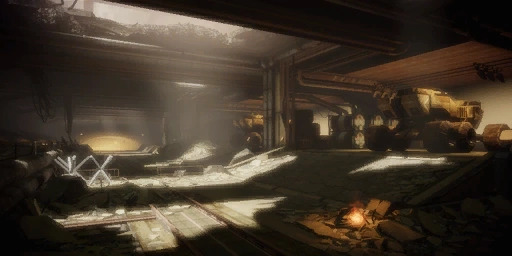
As you are all very well aware, assuming you know your basic history. The united states dropped atomic weapons on Hiroshima and Nagasaki in an effort to halt and ultimately stop Japanese aggression, the result of this action would lead to Japan's surrender, putting an end to world war 2.

That is the common belief held by the US government and the most conservative in the country. But despite this, there has been a real effort to show and express an alternative perspective on the events. To show that the situation was not as clear-cut, black and white as the propaganda makes it out to be, to show that the usage of the nuclear option on Japan was actually a war crime that was not the be all end all solution to the war.

Perhaps the barbarity of Krogan society and so on is analogous to immense cruelty and ruthless fighting the Japanese army were responsible for during world war 2 in the pacific theatre. From an outsiders perspective, it can be viewed as mindless and inhuman behavior emblematic of true evil, It is very easy to dehumanize them as a result and justify dropping atomic weapons on their cities. But it is still important to understand this all has very real and complex causes that require thorough historical and sociological examination...
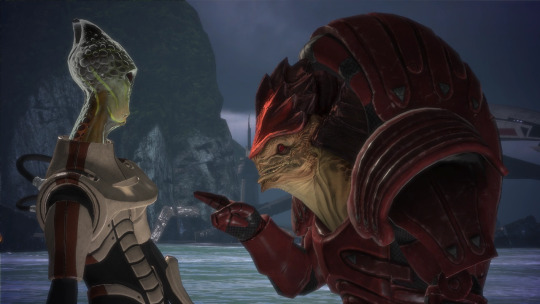
...Just like you as Shepard have to permit yourself to see the Krogan perspective on the genophage in ME1, 2 and 3. Do you believe that the Krogan are irredeemable for their past sins and blow Wrex’s brains out right there on the Virmire beach... Or do you listen and see the Krogan for the deeply complex species they are?

This part of human history was one of the main inspirations for the genophage storyline with its striking similarities.

I MADE A MISTAKE!
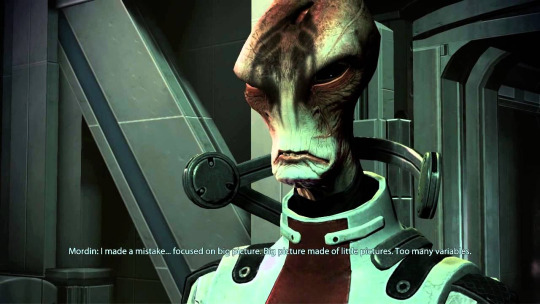
Since Mordin also shows strong compassion and empathetic qualities, he seeks to come to terms with Krogan culture and their perspective on the genophage in his long ideological exchanges with Commander Shepard, which would result in him choosing to cure the sterility plague… or if things go differently he does not. That is just one element playing a role in what ultimately makes him so human… So flawed.
Flaws that he has to overcome or… does not overcome based on how you influence his decisions as a player.
youtube
The distinct visual differences of Mordins appearance, when compared to a regular salarian are pretty subtle… But they were all in service to humanizing the character.

Sculpted recreation of his original conceptual design.
See below in this image, the fundamental design characteristics of salarians that are completely omitted from Mordin Solus. These were intentional decisions to omit the most alien-looking elements from his design so he was more able to emote and be relatable to the audience.
To sell the salarian perspective in narrative and design, there is no other salarian that looks like Mordin in the entire trilogy.
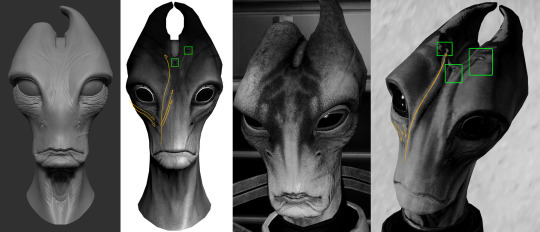
If you were to smooth down and remove all his wrinkles and even remove the unique design elements of his skin, he would probably be the smoothest salarian to have ever existed. Sort of demonstrated this effect in an attempt to make him younger in my artwork here to the right.

Finally, another factor that makes Mordin Solus so human is his love for primarily human art and music, and his preference towards it.
Mordin Solus expresses that he has a strong interest in interspecies theatre and production, but most of the time he expresses this through the performance and creative transformation of human art and music.
youtube
All these humanized design and story factors play a role in subconsciously influencing the viewer to find Solus relatable despite his status as a non-human entity, and this is the same for the rest of his species though with less focus and sophistication in comparison.
youtube
And that is why he is human.
27 notes
·
View notes
Photo
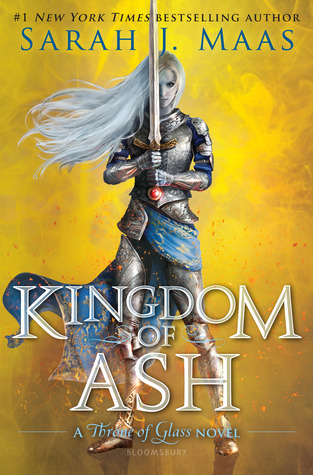
Caitsbooks Reviews: Kingdom of Ash by Sarah J. Maas
Overall: 5/5 Stars Characters: 5/5 Setting: 5/5 Writing: 4.5/5 Plot and Themes: 4/5 Awesomeness Factor: 5/5 Review in a Nutshell: Kingdom of Ash is a fantastic conclusion to a series that has taken over the YA community.
“Hers was not a story of darkness. This would not be the story. She would fold it into herself, this place, this fear, but it would not be the whole story. It would not be her story.”
Blog || Goodreads || Bookstagram || Twitter || Reviews
// Content Warning: War Themes, Mature Content, Graphic Torture (seriously, it's very intense), Sexual Assault (Mention), Death, Murder, Violence, Self-harm, Suicide (Mention), PTSD, Depression, Animal Abuse, Animal Death, Abuse
“Once upon a time, in a land long since burned to ash, there lived a young princess who loved her kingdom …”
- Premise -
Kingdom of Ash is the final Throne of Glass novel. This book takes place after the events of Empire of Storms and Tower of Dawn and follows an insane amount of characters as the war begins.
“Let’s make this a fight worthy of a song.”
- Setting -
I absolutely love the world that Sarah J. Maas has built with this series. This book adds even more onto the lore and even discusses the other worlds, which made me so extremely happy. There were also plenty of things set up in this world even from the first novel that finally come into play in this book, which I found impressive. Sarah J. Maas either is a genius or found clever ways to fix plot holes (or both?)
“Remember that we have something to fight for, and it will always triumph.”
- Writing -
I think it's pretty well known that Maas' writing in the later books has gotten a bit repetitive and much more mature, but I felt that while writing this book she took these complaints to heart. I won't lie and say it's absolutely amazing and no line made me cringe, but it was an improvement from Empire of Storms (I'm not comparing it to Tower of Dawn because that book was absolutely amazing). The sexier scenes were less detailed and more fade-to-black, which is a lot more appropriate for the YA audience and makes more sense considering the plot. However, if that's why you loved this series- sorry! The romance aspects are still adorable though!
“Do you know the story of the queen who walked through worlds?”
- Plot-
This book had a lot to do, and a lot to live up to. I left it feeling satisfied with the ending, but there were definitely a few plot points and deus ex machinas that pulled me out of the book. Mostly towards the end, there was one specific thing that was so out of nowhere that I got annoyed, and the ending itself was a little too neatly wrapped up for how things were solved. I'll get into that more in a spoilery section. As for the pacing, this book was relatively fast-paced and engrossing despite being 1000 pages. There were constant battle scenes and action that moved the book along, mixed with some amazing character-defining moments and even a couple of lines that made me laugh despite the war and death. After a while, specifically the Lysandra and Aedion chapters did get a little slow and predictable, but the other perspectives made up for it. Also, I want to mention that the first quarter of this book has a lot of graphic torture scenes that can be hard to get through. It's absolutely brutal and I found myself having to step back from the book a few times.
“Who do you wish to be?”
- Characters -
The cast of characters in this novel is immense, and I can't talk about every single one, but I wanted to mention a few of the standouts and a few people/relationships I needed to talk about: Aelin - She really had a great arc in this book. We've seen her grow and develop so much over this series, but this book definitely has the most growth for her. I was getting a little apathetic towards her in Empire of Storms, but in this last novel I really began to feel for her again and care about her. Fenrys - If you asked me, before this book, what I thought about Fenrys, I would probably ask you who you were talking about. That said, after reading Kingdom of Ash, I would die for him. Sarah J. Maas developed him into an amazing character who stole the show for me. Dorian - Dorian was one of my favorite characters in this entire series. I need to start with that, because Dorian in this book was just kinda meh. I think part of it had to do with his relationship with Manon. It just felt forced and unnecessary (and this is coming from someone who loved Manon and shipped them back in Queen of Shadows). Aedion & Lysandra - This is another relationship that lost its adorableness for me. I loved them in the previous books, but Aedion said and did some things that really ruined my love of them as a couple. I still like them together, but I wasn't excited to see their relationship develop like I was in the previous books. Chaol - What a journey. I've gone from hating him, to loving him, and this book just cemented how much I love him now. I loved his interactions with Yrene, and how he defies the trope of overprotective husband and lets her make her own decisions and risk her life if it means saving the world. I just love a healthy relationship.
“Her name was Aelin Ashryver Whitethorn Galathynius. And she would not be afraid.”
- Conclusion -
Pros- Lots of action, satisfying conclusion, epic setting as usual Cons- Meh writing, a few unbelievable deus ex machina, lack of diversity, ALSO- check out Aentee(Read At Midnight)'s review which brings up a lot of amazing points Overall- 5/5 stars. Kingdom of Ash isn't perfect, but it is a conclusion that fans of the series will adore, and casual readers will still enjoy.
---------------------------------------------------------------------------------------------------------- Spoilery Section - Only read on if you've finished Kingdom of Ash
Okay I have a lot of thoughts and I want to try to go through them in a way that makes sense, but let's be real, that's not gonna happen. Most of the spoilery things are things I'm disappointed with so if you want positivity... sorry? 1. The Thirteen I loved The Thirteen so much, which is why I hate what happened to them. I understand Maas couldn't let everyone live (more on that later) but why them? The only people who died where them and Gavriel, a.k.a the only people every cared for without heterosexual love interests (and since she tortured Fenrys enough I guess she didn't want to kill him as well). I cried so hard at their deaths, and then when I stopped crying I was just upset. They deserved a better ending than that. 2. Literally no one who lived could be single or straight. Once again, Fenrys is the exception, but let's face it. She's probably going to write a spin-off featuring him and probably ending with him marrying some unnaturally beautiful girl (don't lie, you know the end of this book sets it up perfectly). 3. (Not a complaint) THAT CROSSOVER!!! Did everyone notice Rhys' little cameo when Aelin was falling through worlds???? I loved it so much!!!! 4. (Back to negatives) Gravriel & Aedion's "reunion" Okay, am I the only one loved Gavriel? I adored his character, and I thought this book did a great job developing him, and I was so upset that all that work was done only for him to reunite with his son for one page being killed off. I just felt like it was used as a cheap way to get emotion out of the reader while also killing someone so no one can complain like after A Court of Wings and Ruin 5. Deus Ex Machina That Wolf Fae thing at the end. That was just out of nowhere and really unnecessary. It felt wayyy to convenient and just pulled me out of the book. Also, the entire army dying after Erawan died. That felt like another cheap way to wrap up loose ends. I understand why she did it, and it makes some sense, but it did leave me feeling a little bit disappointed. It was anticlimatic. 6. Character Deaths in General So a lot of people were upset with the ending of ACOWAR, and while SJM clearly did try to kill some people off, it just wasn't done well. She conveniently killed off those who were paired up so this book could have the happiest ending possible, which just made it seem so unrealistic in a series that has always felt down to earth for a high fantasy, assassin-fae YA series. 7. (another good thing!) The Nameless King I just wanted to mention the King of Ardalan. I always wondered why she never gave him a name (I thought she just didn't like naming Kings because she didn't name Hybern), and I love how she actually had a reason! I really loved how she handled his and Dorian's relationship and how Dorian was coping, since we didn't see much coping in Empire of Storms. Also, I loved the reveal of his name. I was afraid if she did reveal his name it would be disappointing, but it really wasn't. 8. Speaking of names- LORD LORCAN LOCHAN Just say it out loud a few times. It's too fun. (Also I love Lorcan and he's precious).
#koa#kingdom of ash#tog#throne of glass#sjm#sarah j. maas#kingdom of ash review#aelin ashryver galathynius#rowaelin#lord lorcan lochan#the thirteen#fenrys moonbeam#books#book#booklr#bookblr#bookish#bookstagram#review#book review#book aesthetic#aesthetic#caitsbooks pics
7 notes
·
View notes
Note
Hi, Jack! We are a new murder mystery roleplay inspired by A Series of Unfortunate Events with new plot twists and characters. We would love some feedback. May we please have an opinion? Please, feel free to take as much time as you need. Thank you so much! We really appreciate it!
hi there @unfortunate-rp! i’m happy to give you an opinion. since you didn’t specify private, i will post this on my blog. feel free to ask me to take it down if that was a mistake.
NOTE: all opinions expressed here are mine, jack’s, belonging to jack. i make no claims to knowing what is best for every group – i only offer advice based on my experiences, what i’ve seen in the community, and my personal knowledge. no one person knows what is best for you or any group other than yourself; because you were the one who put all of this together in the first place. so take everything i say as a suggestion, and remember that you have accomplished so much!!
and if you have any questions, want feedback on something specific, or want elaborations on anything said in this opinion, don’t hesitate to message me!!
this isn’t just an opinion, it’s a shoutout and a rec!! any fans of the asoue book series &/or recent netflix adaptation will adore this rpg. it perfectly captures everything snicket was about from beginning to end and the skeletons are frankly fucking amazing. what a creative admin team!!
start: 2.30 | pause: none | end: 2.58TOTAL: HERE 28 minutes to read all pages (please don’t take this as a measure of anything, I simply time myself and am a speed reader)
*spelling error on /uptown: Mureau Cinema -- Christmas
So the first thing I’m going to say before I go into the full details of each page and contents and such is that I have one big recommendation: finding a way to adjust your line height in your code. The common theme I ran into while reading all of your pages is that after a while my eyes would gloss over certain sentences because I thought I was reading each line but they were too bunched together. Because you have such beautiful pages with so much information to give to your members, this is super important. If you’d like me to see if I can find that part of your code for you, feel free to IM me at any time and I’ll be happy to help.
My first impression of everything is a big fat fucking WOW. From the pages to the graphics to even the way you word things I feel like I’ve been transported back to that dreadfully delightful macabre world Snicket created for me as a child. I don’t know if you’ve been given proper praise for that yet but if you haven’t you certainly deserve it. You have a functional and helpful theme that works for what you need from it and your design of everything is both simple and artistic at the same time. When you have a new acceptance posted the dual ember gifs make it feel like there’s a lot going on but it’s not consistent, with too many repeated or flashing gifs, and so there’s not anything you need to do to change that in my opinion. It just tends to happen with graphics that use the same images. Really though, please feel extremely accomplished about the tone and theme you set on your main. I’ve never gotten more of an impression of what an rpg is about by one glance than I do here.
Your Plot is astounding. Disregarding the fact that you wrote it just like Snicket, I think this is one of the most original fandom concepts I’ve seen in some time. This was the perfect story to be able to take away from the canon and still keep it within the realm of possibility. I’m actually really glad you did this so well because this way people can still have all of the fun of the storyline and plots and not have to worry about the possibility of “playing a canon character wrong” or trying to fit it into the canon of the books/show.
I’ll sort of go into all of your lore pages as a whole rather than go through every single page? Because the love and dedication you’ve taken to ensure potential members and your members have everything they need in order to work within the worldbuilding of your group. I can seriously appreciate that as an admin of a group with a ton of lore, myself. That you go into so much detail on the locations pages and everything about VFD, you make it so your main is the one-stop shop for information rather than asking people to go elsewhere like a wikia page and I’m gonna shout my praises to you for that!
So your Guidelines are something I’m a little iffy on -- and I’m gonna say this is honestly the only thing I really find debatable about your rpg. The very nature of the ASOUE series was about children being involved in all of the gruesome stuff that comes with being an adult; so in that I can see why you allow writers of any age. But you also have content warnings such as smut, violence, drugs, and etc. and state that the roleplay itself will have mature themes and contents. So that being said, I have two moral issues: allowing members under 18 and the playing of characters who are minors. Generally I’m against playing characters who are minors of any kind. That results in using FCs who are minors and yes, while they are celebrities, it gives the potential for undue associations with the child star. Have you considered possibly keeping children out of the RPG except for in the case of mentioned NPCs? Regarding the “members under 18” bit, honestly that one isn’t as much of a big deal so long as your members are tagging and using read-mores where and when needed, but i’ll include that it will deter a certain number of people from joining your group. I’m not telling you to change anything -- but these are things I think you should maybe think about and consider adding changes to?
Your Skeletons and Faceclaims are so widely wonderful and diverse. You have such a wide range of trans characters and I always look for that in RPGs. But you’re also extremely body positive and age positive as well. This is what the faceclaim page of every rpg should look like, so applause for you. I only looked at a few of your skeletons to get a feel for them, but from what I did look at each one is unique in their own way and you have done an impressive job weaving them in with not only one another but the story. Each one has an important role to play and none feel like they’re just there for any sort of token points. You must have put a lot of work into this and you admin/s need to recognize that this immense amount of creativity is brilliantly impressive.
Personally, I think all you need to do is link to your skeleton page with the filters, rather than having a whole page with links that bring people to the tags the filters divide by, but that is more of a suggestion and if you find what you have works for you then there’s nothing more to be said. As for the images on the skeleton page: you obviously make them fit better with the psd/texture, which I like, but some of them still stick out in their brightness. Maybe go back and look at them and dim some of them individually or try to get them with a matching color hue to make them seem a little more uniform?? But the distinction between npcs and skeletons with the monochrome is great.
Overall your graphics match very well!! Your character template is perfect for the vibe and the psd you have on your images ensures they all look very uniform and put-together. The sidebar gif on the homepage feels a little left out compared to the rest, though? I don’t know if you have a lot of history working with gif editing but either changing the size, adding the psd, or adding a little SOMETHING to it might make it seem a little less “floating on it’s own in a void” in your sidebar.
Your Applications, both of them, are very well thought out and you definitely ask for everything that I can see being necessary in this group. Some in the community are against fully fleshed out apps like this but those who see your group and see the effort in your applications should feel inspired with everything that they answer!! You even provide links for them in helping find occupations and such, and that’s going above and beyond. My one thing is…. Why are both applications on bright white backgrounds and not set as pages of your main? It’s just confusing to me, nothing big. And the white sort of startles me after looking at your darker-colored pages for such a long time.
My FAVORITE THING about your rpg: the complete-ness of it all. I genuinely cannot think of one thing I would like to see here, information or rpg-wise, that would help me as a potential member understand your rpg better. You obviously put so much work into everything here and I could not be more thrilled. As the story goes on you might add more pages or such but for an rpg that hasn’t opened yet (at the time I’m writing this) there is NOTHING that needs adding, in my opinion.
My LEAST FAVORITE THING about your rpg: I’m… struggling to find something, but I guess if I had to pick it would be the layout of your applications -- how they exist on a white page rather than within a page on your main. It’s just slightly jarring to go from all that darkness to a bright white page. Think about putting them as pages on your theme and honestly you’re good to go??
OVERALL this is probably one of the best examples of a put-together skeleton and bio rpg I’ve ever seen. Like, I don’t even know anything about the series beyond the show and I had to stop myself from joining while writing this opinion. Even if someone knows nothing about the fandom they could be coaxed to join after just taking a few minutes to look at everything you’ve put together and provided for people. You didn’t leave anything I could think of out and included more than I would have thought if I were the one putting this rpg together. The fact that you may have done this solo stuns me even more. This is an rpg everyone should check out because it has everything people are looking for: diversity, depth, a well-formed plot, and the potential to last for some time with the right cast and crew behind it.
Well fucking done.
Sincerely,Jack
#rph#rpc#rp opinion#skeleton rp#secrets rp#bio rp#shoutout#unfortunaterp#answered#rec#jack does rph things#opinion#unfortunate-rp
1 note
·
View note
Text
Spider-Man - Review (PS4)
10/17/18
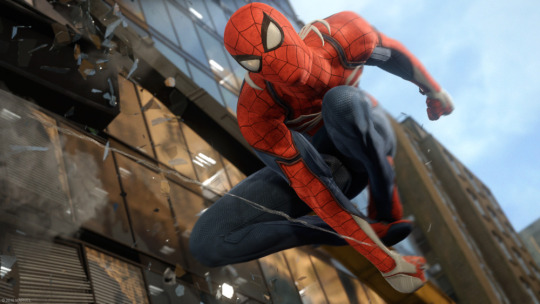
Developed by Insomniac Games
Spider-Man has always been my favorite super hero, but good Spider-Man games are far and few between. My two favorites are the linear adventure game from 2000, which nails the characters and story, but the other widely regarded favorite is Spider-Man 2 from 2004, which introduced realistic web swinging. Somehow, this new Spider-Man game manages to outdo both qualities, and tie it into one epic product. Insomniac Games is an extremely experienced studio, developing games such as Spyro the Dragon, Ratchet & Clank, and Resistance. Not only is Spider-Man the best Insomniac game to date, its one of the best exclusives for the PS4, and is the best incarnation of Spider-Man I’ve ever seen in any medium.
This is a brand new story of Peter Parker and his world, not tying into any other games, films, or comics. Things pick up 8 years after Peter has become the wall crawler, and has lots of experience fighting bad guys and putting super villains behind bars. While he may have tangled with some big names from his lore already, many more villains and side characters have not been mentioned, leaving tons of possibilities open for sequels. Spider-Man also dwells on Peter’s brilliant scientific mind, as he is able to keep pace with Dr. Otto Octavious, and several mini-games can be played conducting research, identifying chemicals, and reprogramming hardware.
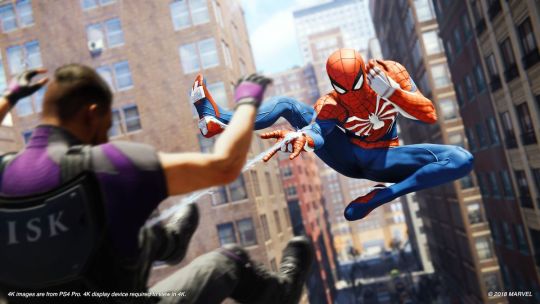
Peter and Otto are designing advanced prosthetics that could change the world, but the two scientists are struggling when the city pulls its grant from their lab. The mayor in this story happens to be Norman Osborn, and a brewing conflict between Otto and Norman fuel much of the story, especially near the end. It’s in Otto’s lab where we conduct most of the scientific mini games, mainly being optional, but can unlock currency to upgrade Peter’s suit and gadgets. Peter also helps out with F.E.A.S.T., an emergency shelter where Aunt May works, and is lead by Martin Li, a man with a secret agenda of his own. The game opens with an exciting tutorial, whereupon Spider-Man is finally taking down a long time rival, The Kingpin, giving us perspective on how far Peter has already come.
One of the main things that took me off guard about this game were how well the cut scenes and characters are done. Not only are the graphics detailed, and motion capture was used for most of the acting, but the care and nuance each character is given in their personality and dialog was constantly impressive. Many of the characters were designed in-game to look like their voice acting counterpart, and many people have genuine chemistry between each other. Mary Jane in particular got a major change, in that she is a persistent investigative journalist instead of a fashion model, and has the capability to help out Peter in many of his outings. No character off the top of my head has any glaring weakness, other than maybe a few by the end of the game not having as much closure or explanation as I may have wanted.

A Chinese gang known as the Demons is slowly terrorizing the city, and act as one of the main entities Spider-Man must go up against. Surprisingly, after the big Wilson Fisk fight, the game feels devoid of super villain entanglements, yet makes up for this in spades with the last portion of the game. It would have been a little nicer to have more than one villain to fight other than The Shocker for the first half of the game, but it’s a small imbalance that doesn’t affect the overall quality or pacing much. Many encounters with squads of goons can be tackled stealthily at first, but usually end up in a big controlled chaos fight. The combat is ripped straight from the Batman: Arkham games, but in this current generation of gaming, this system is pretty much ubiquitous for action/open-world formats. While Spider-Man loses points for originality, it makes up for it in spades with incredible depth the combat system offers. I’ve always thought the “press a button to react” combat was more of a fit for Spider-Man anyway, and I’m glad I finally get to see it in a good Spidey game.
Everything we do earns experience points, and when we reach enough, can use skill points to upgrade gadgets, webbing, and suit powers. Largely, I didn’t take advantage of the depth of the upgrades and unlockables because I found the core gameplay fun and entertaining from the very start. As I write this, I am on my second run at the game (attempting to achieve 100% completion) and just now am experimenting with fighting styles I never used the first time. It speaks to this game’s detail, something you may not think it has at first, especially being a licensed game. However, one of my objective problems with the game is I found the stealth mechanics highly inconsistent. The game tells you when we can safely web up an enemy without anyone else noticing, but much of the time when I would push the button for a clean stealth take-down, it would alert the guards around my victim, launching into all-out brawls.
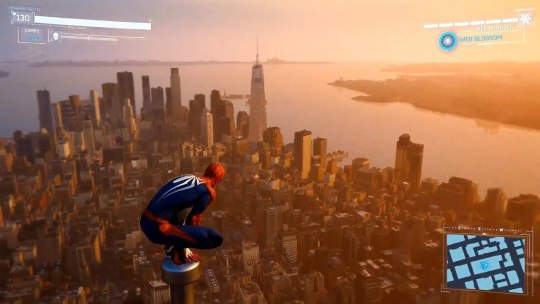
A great detail that Insomniac knew to include was the ability to earn multiple Spider-Man costumes that can be switched instantly at any time. Many of these costumes I recognized from comics and past games, but it also offers modern outfits, such as three suits from the Marvel Cinematic Universe, and original suits all together. Each suit comes with a new power that helps combat and gameplay. The best detail is, once the suit is unlocked, we can use whichever power on whichever suit. This lets you pick both your favorite gameplay buff, as well as look exactly how you want Spidey to look during the game. I also love how the costume translates into every single cut scene, further immersing you into the story in your own little way.
Aside from the main narrative, tons of side missions can be played, but also with varying quality. Most of the citizens who offer quests have stories worth experiencing, and that play into the character of this version of Manhattan. Other quests can be glorified collectathons or challenges, which luckily are optional to complete. Even still, they usually offer further insight into Peter’s personality, intellect, or into the personality of other characters involved. Easily the best part about the gameplay is the web swinging. Traversing Manhattan is delectable, and an absolute blast. Peter has tons of natural looking animations that make him look graceful and realistic. Having to attach webbing to actual surfaces gives locomotion dramatic weight, and lots of fun payoff. Peter can also web zip forward, maintaining horizontal speed, given that there is an object in the near distance in front of him.
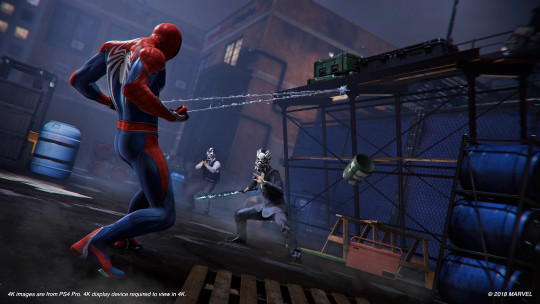
What also helps immensely is the smooth 60 frames per second that the game runs on. Every web swing feels and looks graceful, and even into my second time completing the game, was discovering new tricks to keep momentum going forward, things that the game lets you discover for yourself. For the first time in any open-world game, a blip on my map over 3,000 meters away, rarely felt like a hassle. I looked forward to going from one place to the next almost every single time. The game offers a quick travel mechanic, but I honestly believe it isn’t necessary in a game where going from one place to another is so consistently thrilling. This is a big aspect of the game I’m sure Insomniac knew they had to nail, and they passed with flying colors.
Spider-Man (or is it “Marvel’s Spider-Man”?) is a brilliant representation of the wall crawler, and is an extremely fun open-world game. Everything from the graphics, to the combat, to the web swinging, to the music is all done excellently, and is easily worth its $60 price tag. While I’m not a huge fan of every type of side quest or mini game, the core of the game’s narrative and heart makes any small imperfection look that much smaller. The poorer qualities of the game are only seen as worse because they’re surrounded by so much greatness. This has become the quintessential version of Spider-Man and something I will compare every future incarnation to. I was so pleased and so impressed around every corner, I still can’t believe this game turned out as well as it did. Absolutely worth plaything through to see the story to its end, and purely for the fun of every minute of the experience.
9.5/10
#spider-man#spiderman#peterparker#marvel#ps4#ps4exclusive#openworld#videogame#review#cantwaitforthesequel#insomniac#insomniacgames#comicbook#superhero#manhattan#nyc#nycwallcrawler
3 notes
·
View notes
Text
Superman & Lois: Inside the Season’s Big Twists and that Finale Ending
https://ift.tt/3ANytYo
This article contains major Superman & Lois spoilers. Don’t read until you’ve seen all of season one!
Superman & Lois Episode 15
The Superman & Lois season finale, “Last Sons of Krypton,” has finally arrived and it’s as big as you might expect. For a series that started off teasing lots of family drama and that eschewed the traditional Metropolis setting for the (theoretically) friendlier confines of Smallville, it was full of blockbuster-scale action in the second half of its 15 episode run.
“Last Sons of Krypton” effectively wraps up the season’s blockbuster elements in its first two acts or so, before offering a series of codas that tie up nearly everyone’s arcs with a sense of finality usually reserved for a series finale, not just a season one. Well, with one major exception, of course.
And when you think about the journey this season took viewers on, that’s a lot to wrap up. From the Captain Luthor is actually John Henry Irons twist to the Morgan Edge is really Superman’s Kryptonian half-brother concept and everything else in between, the first season of Superman & Lois was unlike any Man of Steel tale we had seen before. It’s something that showrunner Todd Helbing says came out of an early desire to tell a “different” Superman story.
“There was nothing that was off limits,” Helbing says. “It was kind of like, we’re going to do this. Let’s just swing for the fences, and hopefully we connect on a couple of these.”
Let’s take a look at some of those big characters and concepts the show tackled in its first season, and talk about that multiverse-shattering ending.
JOHN HENRY IRONS
Those “big swings” Helbing alludes to came early on. The initial “Captain Luthor” reveal wasn’t supposed to be a fake out at all, and the idea that he was really John Henry Irons from an alternate Earth came along organically during the writing process.
“When we watched the first cut of the second episode, we knew that there was something missing that you could feel in the pilot,” Helbing says. “So we wrote a few new scenes and then a couple more for episodes three and four. From there on it kind of snowballed, and we brought up a lot of stuff that we were going to do later, and we paced up the show. I think when the John Henry Iron’s idea came, it sort of gave us this confidence, because we knew that it if we could keep it a secret, that it was really going to work.”
The secret was kept, and virtually all online speculation about the nature of Captain Luthor was proven wrong. And in the process Wolé Parks became the definitive live action version of beloved DC Comics hero Steel.
MORGAN EDGE, TAL-RHO, AND SUPERMAN’S BROTHER
Unlike the Captain Luthor/Steel thing, however, Helbing and company knew going in that Morgan Edge was going to turn out to be the malevolent Kryptonian Tal-Rho, and specifically that Tal-Rho would be Superman’s biological half-brother.
“That was part of the pitch,” Helbing says, before clarifying that not all of these elements were set in sunstone from the outset. “There were some things, some twists and turns…a lot of it was the writers and talking to Greg. The staff that I get to work with every day, they’re really talented people who love Superman, and we all just really clicked, so it was great.”
Read more
Movies
Superman Movies Ranked: The Best and Worst of the Man of Steel
By Mike Cecchini
With Tal-Rho there are surprises within surprises, as DC TV shows aren’t known for creating original villains for a season’s big bad.
“We knew we wanted to tell a mythology that hadn’t been told in live action with Tal-Rho being the half-brother,” he says. “It was really just, how do we pace this reveal out?”
But Edge/Tal-Rho, despite being both unpleasant and immensely powerful (a perfect recipe for villainy) is an almost tragic figure, especially when compared to other supervillains.
“It would have been pretty easy for him to just become a mustache-twirling villain,” Helbing says. “But on our show, we want everybody to have a point of view, whether the audience agrees with them or not, and this includes our villains…The villain part of it is great, but it doesn’t mean anything unless you understand where they’re coming from, you can get into the emotion of it. And I think him being related to Kal-El and just all of his pains and struggle, that’s really where it worked.”
THE ERADICATOR
Despite the fact that Tal-Rho himself is an original character created for TV, the character eventually evolved into another important figure in Superman lore: The Eradicator, perhaps best known to fans as one of the “replacement Supermen” who appeared in the wake of the Man of Steel’s death at the hands of Doomsday.
But it turns out that the Eradicator wasn’t part of the plan, initially. Edge, of course, was taking humans and infusing them with Kryptonian souls and powers, turning them into “subjekts,” and there was one in particular who was going to tower over the others.
“Originally we started laying out these ‘subjekts’,” Helbing says. “We were going to build up the Subjekt-17, but it became very apparent that we weren’t just going to do 16 subjekts in a season.”
(NOTE: Subjekt-17 was a villain who only made a handful of appearances in the comics, an alien baby discovered by the Soviets and held in stasis for decades, before eventually wreaking havoc on Superman and friends. It’s part of an unfairly overlooked Superman storyline by Kurt Busiek, Carlos Pacheco, and Jesus Merino, and you should check it out. But I digress…)
Once the Subjekt-17 concept became unworkable, the Eradicator’s name arose.
“The Eradicator was brought up pretty early on, but that was one of the elements where like, okay, we’re going to see how this plays out and how we’re going to be able to make this land the best way,” he says.
Of course, bringing the distinctive comics look of the Eradicator to the small screen brings its own challenges.
“When you look at some of the art of the Eradicator, you’re like, how do we translate this? Do we give him Ray-Bans or something?” Then we just kicked that idea around and came up with the way he is in the show. I think it’s pretty cool.”
LOIS LANE AND JORDAN KENT
But amidst all the Kryptonian fighting and love for Superman lore, the finale’s highlight is the moment where Elizabeth Tulloch’s Lois Lane pulls Jordan Elsass’ Jonathan Kent back from the brink, after his personality has been “eradicated” by the soul of Tal-Rho’s evil father. Lois does what we’ve seen her do several times this season, which is (with the help of some Kryptonian tech this time) help Jordan “push through his darkness” in an emotional scene that’s as triumphant as any bit of high-flying action we’ve seen throughout the season.
For Helbing and the Superman & Lois writers, it was a moment that happened naturally when working on the final two episodes of the season.
“That stuff was all kind of by the seat of our pants,” Helbing says. “We knew emotionally what needed to happen. We knew the sort of format and structure that we wanted to do in episode 14, two acts of family setup, town drama, get all that stuff up and running and then it was four acts of action. But episode 15 starts with four acts of action, and then ends with two acts of the emotional landing. But that one particularly, there was just a lot of [writers] Kristi [Korzec], Mike [Narducci], Brent [Fletcher], me, and Greg [Berlanti]. Where are the places that we have to land emotionally? Let’s build the story around that, which we did.”
NATALIE IRONS RETURNS
The episode doesn’t quite wrap up everyone’s emotional arcs. We’ve known for some time that Irons is still dealing with his feelings for Lois, even as he has accepted that this isn’t the same Lois he was married to on his world. Just as he seems to have made peace with the notion of moving on, and that he can’t stay with the Kents any longer, the multiverse throws everyone quite a curveball…as a mysterious craft falls out of the sky and reveals John’s daughter Natalie Irons (Tayler Buck) has somehow survived and made her way to this world.
Helbing won’t give many details yet on what to expect for Natalie Irons in Superman & Lois Season 2, but he does reveal that they’ve already written the season premiere.
“We knew Nat was going to show up, and we knew we wanted her in the show, because we want to explore a new family dynamic,” he says. “I’ll just say, in season two, there’s a lot that everybody is dealing with, having to get used to new members of a family, I’ll just put it that way.”
We’ll have more from Todd Helbing about Superman & Lois Season 2 soon!
cnx.cmd.push(function() { cnx({ playerId: "106e33c0-3911-473c-b599-b1426db57530", }).render("0270c398a82f44f49c23c16122516796"); });
What did you think of the Superman & Lois season finale? Let us know in the comments!
The post Superman & Lois: Inside the Season’s Big Twists and that Finale Ending appeared first on Den of Geek.
from Den of Geek https://ift.tt/3xWs2jO
0 notes
Text
Doctor Who Review: Season 14 (1976-1977)
Tom Baker’s tenure as the Doctor really hit the ground running with a strong first two seasons. So how does his third season compare? Well I’ve just finished watching it, so let’s get right into my review of Season 14 of Doctor Who.
The Masque of Mandragora

An intriguing premise with a decent execution. The sets and costuming were excellent, which unfortunately detracts from my enjoyment of the story as I find the clothing of the time to be totally ridiculous. The acting of the supporting cast was also rather average, and Hieronymus especially was incredibly overacted – almost like a pantomime character. The supporting characters were also paper thin, and underwhelming, the only enjoyable characters being Count Federico and Marco. Also Marco and Giuliano were, to use the technical term, so gay, and it was great. Some of the sound design was also grating and aggravating. I’m a fan of the Secondary Control Room (though I prefer the Primary one). 6/10
The Hand of Fear

I am truly heartbroken. Actually heartbroken. But before we get into that, let’s look at the story. And my god what a story it was. An intriguing opening led on to one of the most tension-filled moments of the classic series so far and really set the tone for what was to be an incredible story. The effects of the disembodied hand were impressive, the location for the power plant was excellent, the sets on Castria were very well done and the costumes for both versions of Eldrad were also great, though his first form was done a lot better than the second. The acting of both Eldrads was also amazing (though, again, the first was much better), and the rest of the supporting cast, bar some moments from the quarry workers and Driscoll, was outstanding. Elisabeth Sladen also shines as a hypnotised Sarah Jane. The story itself was compelling and executed perfectly, save for one of the weakest, silliest conclusions in the show’s history. And of course, the final moments between the Doctor and Sarah were some of the best minutes of Doctor Who ever produced. I absolutely loved this story. 8.5/10
The Deadly Assassin

What an incredible story! There was never a dull moment throughout it, though I would say that the third episode flags slightly and the opening narration and the Doctor talking to himself at the beginning were poorly done. What I enjoyed the most about this story was how it added so much to the lore and mythos of Doctor Who, and in particular, of Gallifrey. For example, this is the first story to establish that a time lord can only regenerate twelve times. The way the Matrix was handled was incredibly clever, and the battle of intelligence between the Doctor and the Assassin was brilliant to watch. Their physical confrontation somewhat less so. It was also incredibly predictable who the Master’s accomplice would turn out to be. The supporting characters of this story were also fantastic, with a very diverse and enjoyable range of personalities and traits. I particularly enjoyed the character Engin, the bumbling old Coordinator of the Matrix. The design of Peter Pratt’s Master was at once somewhat unsettling and slightly hilarious, but the effect is very commendable, especially for the time. The sets and costuming for the rest of the story were also incredible. Another all around fantastic story. 9/10
The Face of Evil

An intriguing premise with a satisfying execution. The costumes and sets were all fantastic. Unfortunately, the guns looked ridiculous, and some of the effects, especially the gunfire, were awful. The design and voice work of Xoanon and his “pets” was spectacular though. The acting of the supporting characters was very good, but unfortunately this story also started with the same mistake as The Deadly Assassin, with the Doctor talking to himself in an incredibly unnatural manner to explain what was happening. It feels very condescending to the audience, and I think even children would have understood what was going on if it was presented in a more natural way. I also have some problems with the upper class voices of the supposedly savage Sevateem. I enjoyed the character of Leela a lot more than I expected to, and I look forward to seeing more of her in future. Overall a brilliant idea with a very good execution. 8/10
The Robots of Death

A decent story. It managed to do away with all intrigue in the second episode when it showed the legs of the villain, who was the only one to wear trousers that looked even remotely the way they did. The acting and sets were great, and while the costumes were good for what they were, I found them quite silly. The model for the sandminer was aesthetically my favourite part of the story. I enjoyed Uvanov a lot more than I initially thought I would, as he is not the one-note character he appears to be. Conversely, the character Poul was one I liked at first, but grew to dislike. The idea of robophobia was not handled well. D84’s voice was poorly done, and the villain’s costume at the end was ridiculous. The ending of the story was quite ingenious, if a little silly, but executed slightly poorly. Overall it was a good story, but nothing special. 7/10
The Talons of Weng-Chiang

I think something about six-part stories is that they usually flag around the middle. The Talons of Weng-Chiang is a good story, but it doesn’t really deserve its awesome reputation. The villains were overacted, and the portrayal of Chang was rather racist, though less so than one might expect. The fact that Leela called him a “yellow man” was also rather odd, considering she comes from a time that wouldn’t have used terms like that, and because Chinese people don’t actually look yellow and thus she couldn’t have come up with it herself. In a recurring theme with these masked villains, “Weng-Chiang” looks a lot better with his mask than without, but this time it is simply because his true appearance is rather disgusting. It is, however, fairly well done. As are the costumes (though I greatly preferred “Weng-Chiang’s” original costume to his later robes) and sets, and, of course, the enormously creepy Mr. Sin. There was also a surprising amount of comedy, much of it coming from the unintentionally hilarious giant rat. Its other chief source was the uncivilised Leela playing off the upright and proper Victorian setting. Leela also continues to show herself to be a total badass throughout this episode, though she is unfortunately hampered by the demands of the plot. The character of “Weng-Chiang” while at first an intimidating mystery quickly becomes an immensely aggravating, tantruming, incompetent child, and while that may have been the intention, it doesn’t make for an entertaining villain. I am very fond of Litefoot, but, while Jago had his moments, he was usually a rather irritating presence in the story. Some scenes were difficult to see clearly. All told, Talons is certainly a good story, but nothing spectacular. 7/10
Overall, another mixed bag of stories with some high highs, but no true lows. The loss of Sarah was a blow, but Leela seems to be a fitting replacement and I enjoy her immensely. I look forward to seeing her shine more in future. There were some rather excellent stories to be found here, and none that I would call bad, but some were not very compelling. The supporting cast were decent for the most part, but Tom Baker, Elisabeth Sladen and Louise Jameson continually impress. A fairly good season when all is said and done. 7.5/10
My ranking of the stories is as follows: 6. The Masque of Mandragora 5. The Robots of Death 4. The Talons of Weng-Chiang 3. The Face of Evil 2. The Hand of Fear 1. The Deadly Assassin
#review#doctor who#doctor who review#classic doctor who#classic doctor who review#Fourth Doctor#tom baker#the masque of mandragora#mandragora helix#mandragora#hieronymous#count federico#the hand of fear#eldrad#the deadly assasin#the master#peter pratt#the face of evil#xoanon#the robots of death#voc#super voc#dum#robots#the talons of weng-chiang#li h'sen chang#weng-chiang#magnus greel#mr sin#henry jago
3 notes
·
View notes
Note
Do you ever think DDS1 was better than DDS2? Don't get me wrong, DDS2 had its moments, but IMO, I think DDS1 was better because Matt was taking down Wilson Fisk both as Daredevil and as Nelson & Murdock. In DDS2, I think the narrative suffered as the Hand storyline only really was tied to Daredevil (and only very indirectly tied to Frank Castle), while the Frank Castle storyline from DD 2x04 to DD 2x10 was primarily connected to Karen and to Nelson & Murdock.
DDS1 and DDS2 are actually fairly evenly matched as personal favs in the Netflix universe. The things I really loved about each one individually are probably the things I didn’t like in the other, and that’s probably why one season doesn’t quite top the other for me.
DDS1 was a super badass, viscerally rendered introduction to this character and its universe for me. I came into it with only the barest of knowledge about Matt Murdock / Daredevil, and was skeptical whether it would be a good TV show, or just an entertaining superhero show (I was, and still am, an unabashed tv snob). But I was surprised at how much I loved the characters, loved the story, and I loved the way it subverted my expectations of the genre. It was dark and compelling and kept me at the edge of my seat for so many episodes – in fact, I clearly recall my husband and I starting our initial watch and how we kept going “oh shit” at the end of each episode in the first half…like we HAD to keep watching. It was this slow burn, gradual layering of all of these interconnected pieces into this glorious whole that made it such an ambitious season of television. BUT I think for all of its ambitions, and they really did hit the mark on so many of them, the pacing and plotting started to fall apart for me in the last third of the show (with the exception of Nelson v Murdock). It definitely felt really draggy in that last stretch and the last episode felt almost unearned in the wake of what had come just before. I still ended the show on a really positive note, and on subsequent rewatches I haven’t minded it as much b/c I’m already invested in the story, but yeah, it was something I remember thinking to myself that really prevented it from being really up there in my top 10 first seasons of TV. Thematically, they nailed this origin story for me, for sure.
As far as badassery goes, DDS2 is pretty damn evenly matched with DDS1, but for different reasons. I think if DDS1 succeeds as this gritty, subversive take on a comics origin story, DDS2 succeeds in its unabashed embrace of expanded Daredevil comic lore to expand its corner of the DD universe, bringing in really iconic characters in the form of Frank Castle / Punisher, Elektra, and even the Hand (more on this later). And the general storytelling beats and thematic interaction between Matt and Frank + Matt and Elektra (defining good / bad / morally grey, what does it mean to be a hero) were done supremely well. The way they both pushed and challenged Matt in his own character development were really intense, but also delightful to watch. I also think it gave Charlie Cox a lot more to do and highlighted aspects to the Matt Murdock character we hadn’t had much of an opportunity to see in S1, which was overall pretty dour and depressing in tone. But I think where the season trips up badly is the way the overall story was plotted. I appreciated the sense of arcs in this season compared to S1 – 1-4 being Punisher focused, 5-8 being Elektra focused, and then 9-13 being what should have brought it altogether to a cohesive close…keyword being should. And this is where I guess I should bring up the Hand. Being a comics reader, I appreciated the idea of bringing the Hand into this universe because as different as it is from the gritty crime stuff, it factors into DD’s comics adventures quite a bit, and I rather liked the idea of him having to combat more diverse threats as he comes more and more into his own as a superhero. The problem with the Hand was its existence in S2 felt entirely separate from the story they were actually trying to tell and in trying not to give too much away before IFS1 and TDS1, kind of just tied everyone’s hands a bit as far as dealing with it as a credible threat. And there was a huge missed opportunity to tie it to the Punisher arc as far as the payoff on the drug story goes imo, in fact I remember being kind of stunned it didn’t go that way? Anyway, so DDS2 holds an extremely fond place in my heart for more specific character arc / interaction reasons, but fails on the overall storytelling part.
I guess after writing this, I’m realizing I disliked aspects of the way the story was plotted in both shows, so that’s consistent. But they definitely succeeded on some of the same things, like creating really strong, memorable characters and character driven drama. As a fan of the comics, I probably give DDS2 more of a pass than others who are mostly there for the gritty crime thriller take on DD, but I also think being able to occasionally transcend that dark tone only makes the show and its characters richer and more interesting to watch.
Anyway…we’ll see what DDS3 serves up for us next year. I don’t really want them to just reboot back to the formula / status quo of DDS1 because like it or not, the characters have all gone through an immensely transformative story from DDS1 > DDS2 > TDS1…I think there are new ways to tell the story that can serve the characters individually as well as pull in what has worked well from each of the seasons before. Fingers crossed that the writers will find a good grasp on how to balance all of those pieces!
#dmcreif#asks#answers#marvel's daredevil#dd s1#dd s2#matt murdock#daredevil#frank castle#elektra natchios#meta#text#my thoughts#p talks about stuff
14 notes
·
View notes
Text
Gore Reviews Magic: The Gathering – Duels of the Planeswalkers 2014
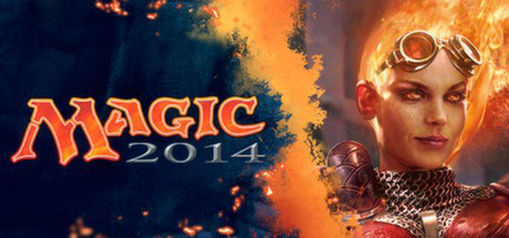
Release Date: June 26, 2013 Platforms: Microsoft Windows, PlayStation 3, Xbox 360 (reviewed), iOS, Android
It is summer time and we know all know what that means. No, I’m not talking about burning alive in the hot sun or possible death from heat stroke. Well those are legitimately answers as well, but I’m talking specifically about a new Magic: The Gathering Duels of the Planeswalkers game. The Duels franchise is slowly turning into something akin to Madden or Call of Duty with its yearly releases and while a game like Magic should be able to pull this off (because it adds hundreds of new cards to the game each year and has thousands of cards from the past to tap into), let’s not jump the gun with an assumption like that so quickly.
Magic is a game I’ve grown very passionate about over the last couple of years and while my IRL play has been significantly cut down, I still follow the game very closely. Each year I very much look forward to getting my hands on the latest Duels game because it lets me play the game I love when I can’t get together with friends. So it’s unfortunate that I have to say this, but Duels 2014 doesn’t quite live up to expectations and the series may have finally peaked and be on the decline.
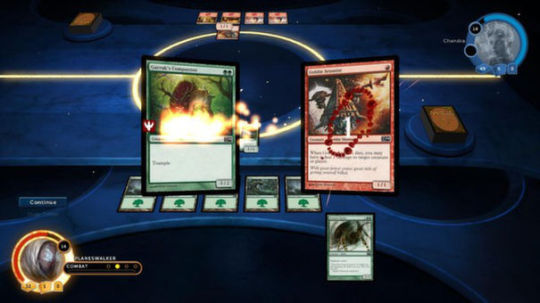
Like years past, the single player options consist of the usual campaign, revenge campaign, challenges, and custom free-for-all or two-head giant matches. This year the campaign has you working with Planeswalker Chandra Nalaar and traveling to various planes within Magic’s lore to collect items in order to track down the elusive Ramaz. As with the other Duels games, the story means very little and most probably won’t give it a second thought. Where I draw the biggest issue with the campaign is due to its focus on encounters, which play out almost exactly the same each time. This sort of kills what makes Magic so great, it’s unpredictability. This is just a minor complaint as these are still fun to work through in most cases. After completely a few of these encounters, you’ll face the “boss” of that particular plane and actually get to play a real game of Magic. Upon defeating this opponent you’ll unlock their deck, as well as the next plane.
One “feature” in the campaign that felt rather tacked on was the ability to battle Magic’s original five Planeswalkers (Ajani, Jace, Liliana, Chandra and Garruk). Within each plane you’ll be able to pick one of the five to do battle with and by defeating them, you’ll unlock their deck. This feature is so unintuitive that I didn’t even notice it was available until I was halfway through the campaign. What’s even worse is that two of the Planeswalkers’ (Chandra and Garruk) decks are unlocked from the beginning, so facing them feels almost pointless. Luckily the revenge campaign stacks these five Planeswalkers and all of the “bosses” from the campaign and into a progressive ladder with no story or encounter filler, making for a tougher and much more satisfying experience.
The challenges in each Duels game are something I always look forward to, but unfortunately 2014’s were completely underwhelming. Out of ten challenges only one of them even slightly posed a real challenge to complete. It was like the developers just felt it was necessary to put them in because they’ve been in the series from the beginning and then proceeded to half-ass the job. I’m all for beginner challenges that help new players learn certain mechanics and tricks the game offers, but having every challenge feel like “baby’s first Magic game” was really disappointing.
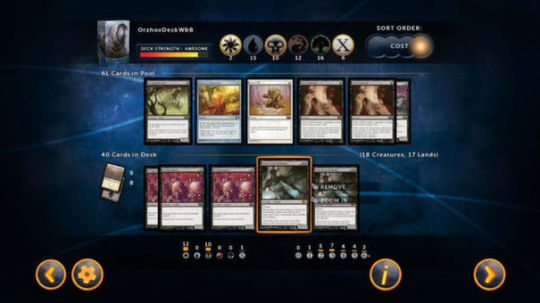
Arguably the most important part of any Magic game is the deck selection you have at your disposal. Unfortunately, this is another sore spot in Duels 2014 for me. Like most of the previous installments you’ll have 10 decks available (once you’ve completed the campaign or paid to unlock them) and each has 30 cards to unlock to help you develop more powerful strategies. In years past Stainless Games has struck a beautiful balance between each deck, but this year the balance (or lack thereof) was all over the place. There are two or three decks that are completely overpowered, a few mediocre decks, and a couple that are basically unplayable if you want to win. This is honestly the most disappointing issue with Duels 2014 as unlocking each card has always been something that I’ve found quite enjoyable, but I’ve found myself unable to consistently win with a couple decks (even battling AI on the easiest difficulty) and that has deterred me from continuing the pursuit.
This issue becomes even more glaring when you step into the world of multiplayer. This is where most players will probably spend most of their time with the game and from my experience it just isn’t fun like it was in years past. When everyone plays the same two overpowered decks, the variety and enjoyment plummets immensely. Add on top of that the fact that the Steam version of the game is running rampant with cheaters and hackers, which Stainless apparently has no desire to address or fix, and the fun, competitive online experience that some may be used to, just isn’t there in Duels 2014.
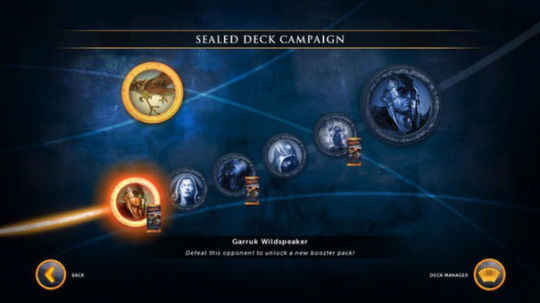
The biggest addition to Duels 2014 and perhaps the game’s saving grace is the introduction of sealed play. While the sealed play in Duels 2014 isn’t quite the same as you’d see in paper Magic, it’s still something new, different, and enjoyable. In 2014’s version of sealed play you’ll start with six booster packs, each with 14 cards, in which you use to create your own custom 40 card deck. Once you’ve opened your packs and built your deck you’ll get to play through the single player sealed campaign, which allows you to unlock an additional three booster packs to further enhance your deck. This is the first time you’ve ever been able to create your own deck in a Duels game, so this feels like a major step forward. Also worth noting is that you can finally adjust your lands as you see fit (even with the 10 pre-constructed decks) for the first time as well.
Duels 2014 comes stock with two sealed slots you can use for free, each with its own pool of six boosters and three more unlockable via the campaign. You also have the option to buy more slots for $2 each if you want to build more decks or just want to try and get a little luckier with your pool. Compared to IRL Magic, $2 for 9 boosters isn’t too shabby, especially if you plan to take your sealed decks online, which will greatly extend their life making the $2 investment far more worthwhile.
The online sealed play is a much more refreshing environment when compared to the pre-constructed online games. Here you’ll definitely see a much wider variety of decks and because of this, games feel far more competitive and unique. There’s still the pesky problem of cheaters and hackers (mostly on the Steam version) that are just out to ruin days. While I played on the 360 and didn’t experience any cheating (that I know of), it still seems worth noting if you’re looking into possibly purchasing the Steam version of the game.
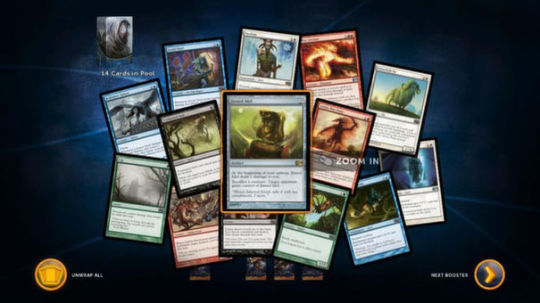
Duels of the Planeswalkers 2014 is a completely solid and competent game when it comes to gameplay, presentation and mechanics, but there are a number of issues holding it back including its unbalanced pre-constructed decks and completely lackluster single player campaign and challenges. There is one shining light and that comes in the form of sealed play. If you’ve always wanted to build your on deck in a Duels game, you finally have that chance, although on a limited basis. So if you’re a fan of the Duels series or Magic in general, it’d be hard not to recommend this, but just know that Duels 2014 is somewhat lacking and definitely isn’t the best game in the franchise.
Score: 3 out of 5
0 notes